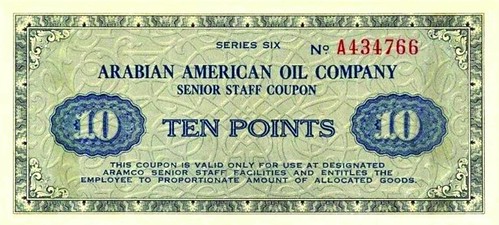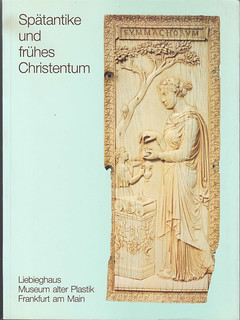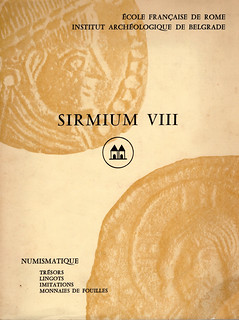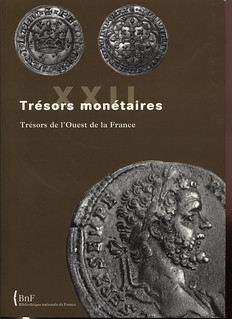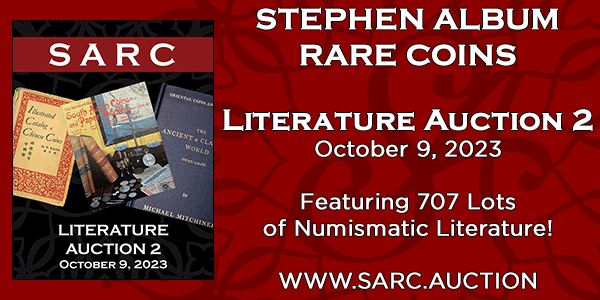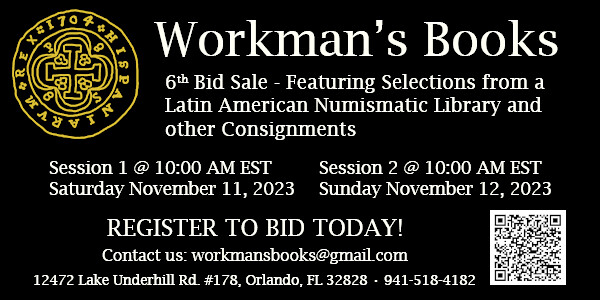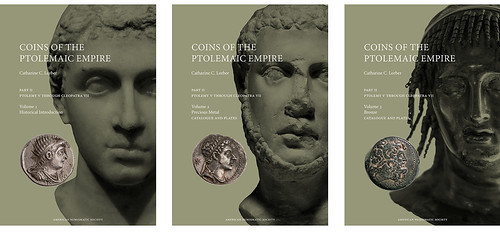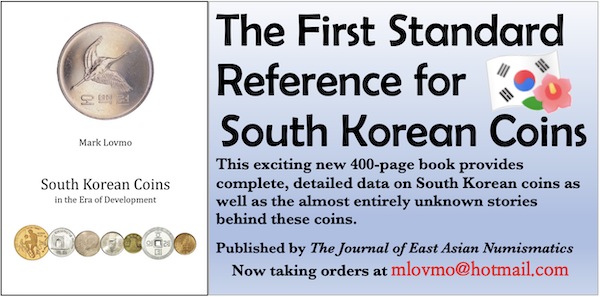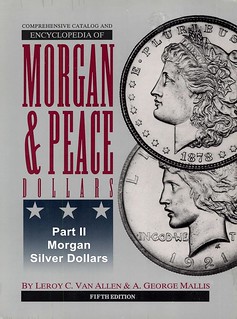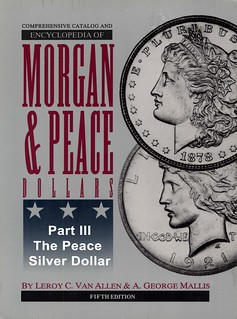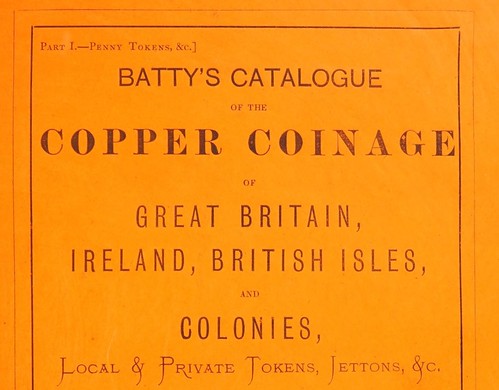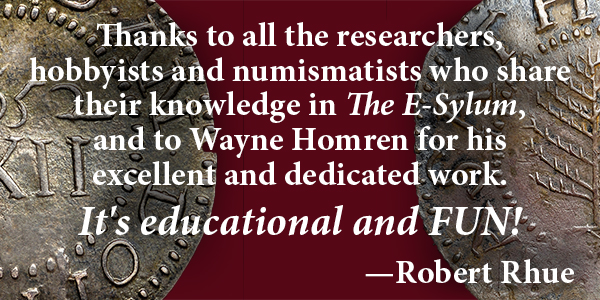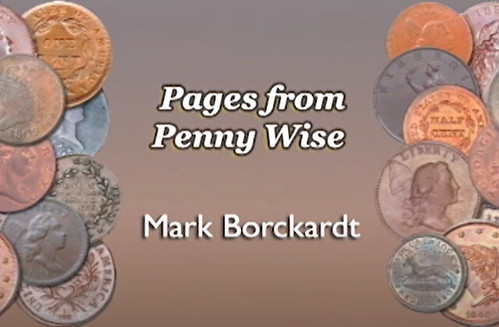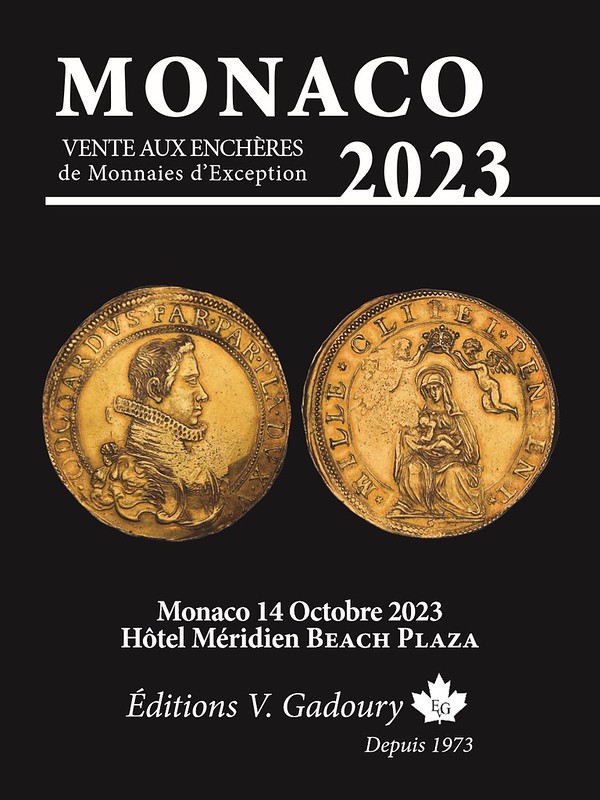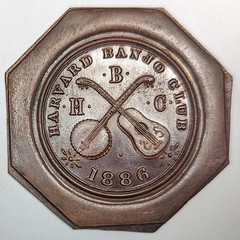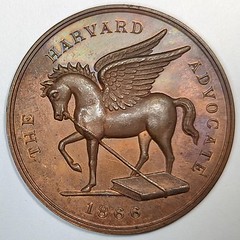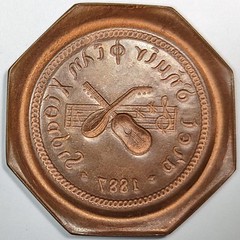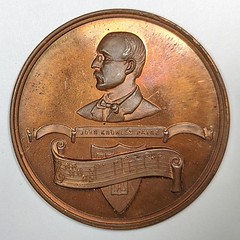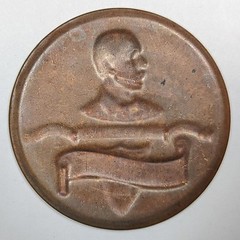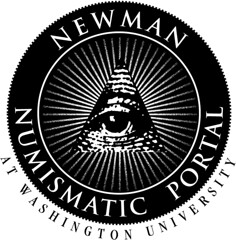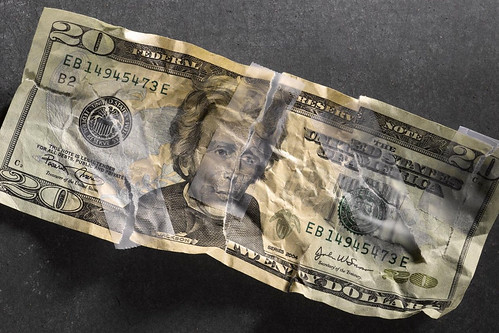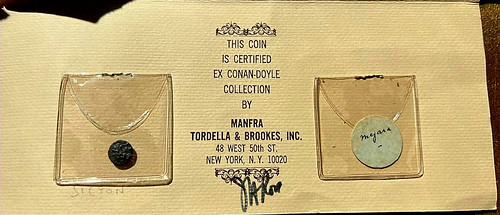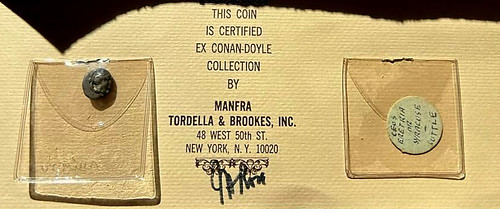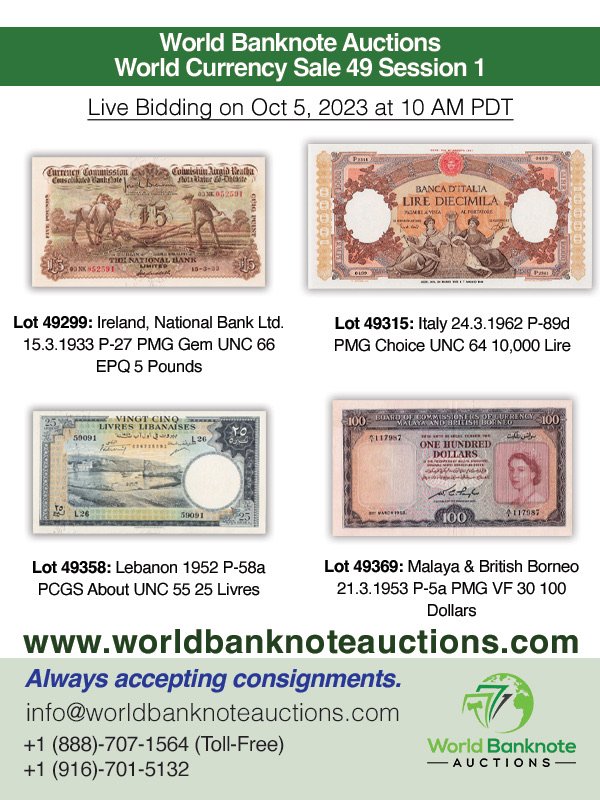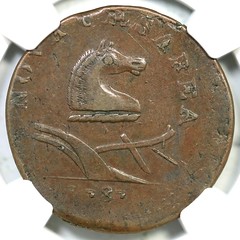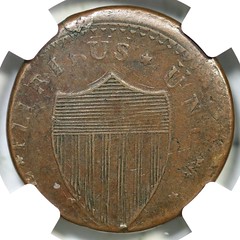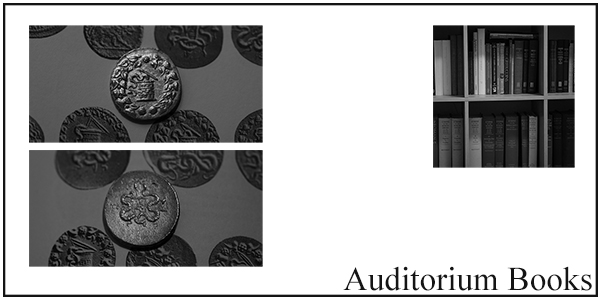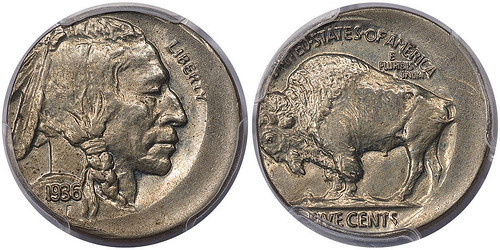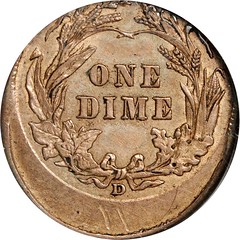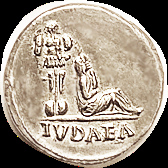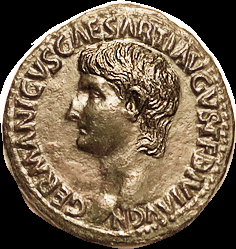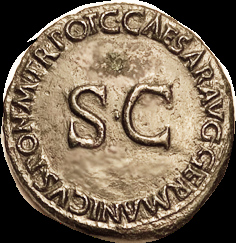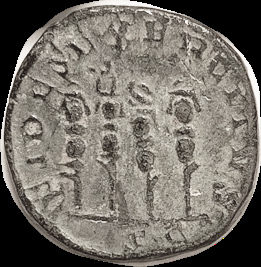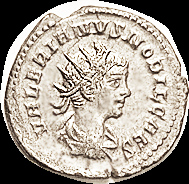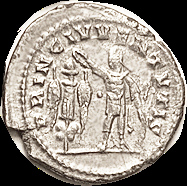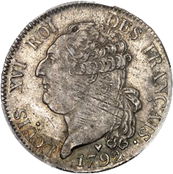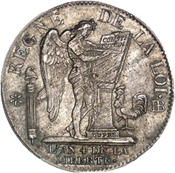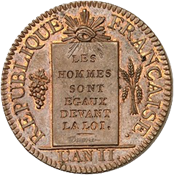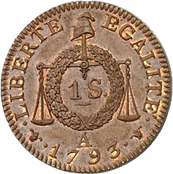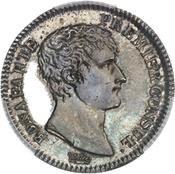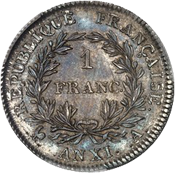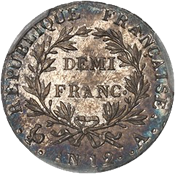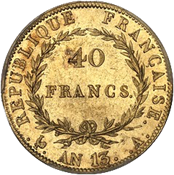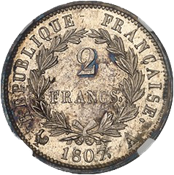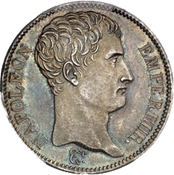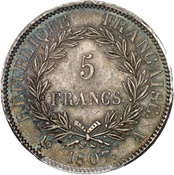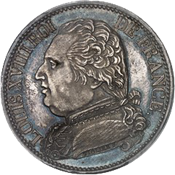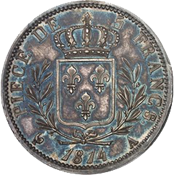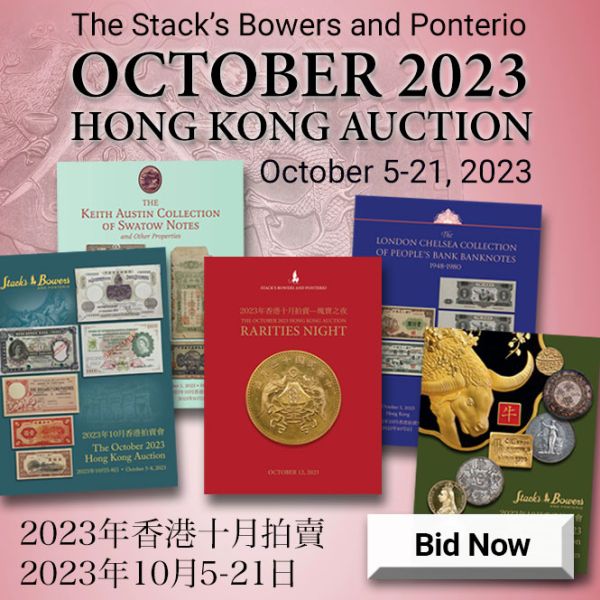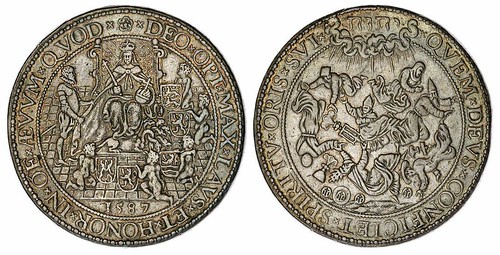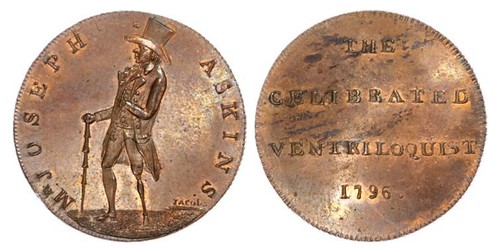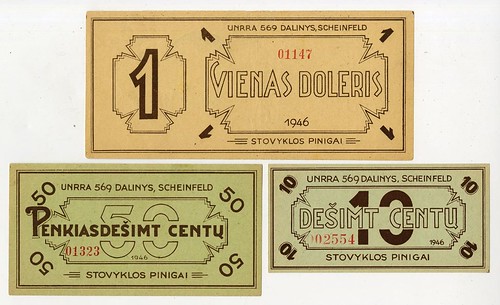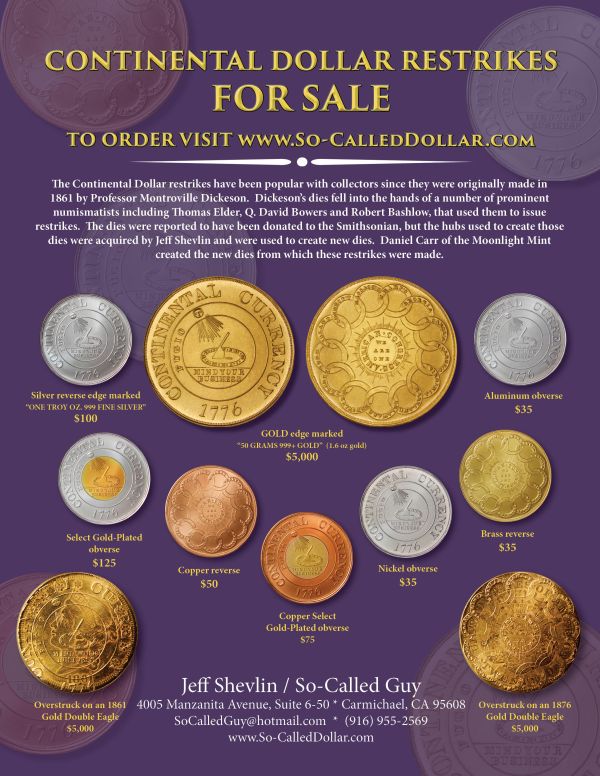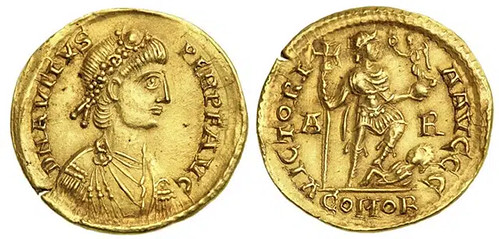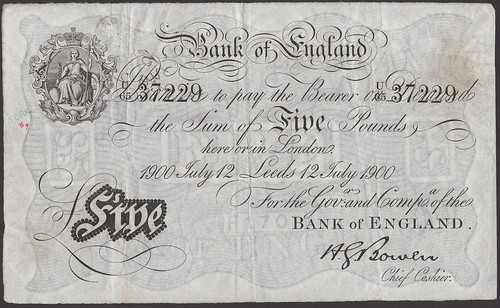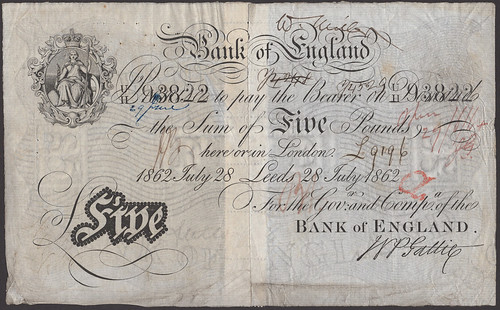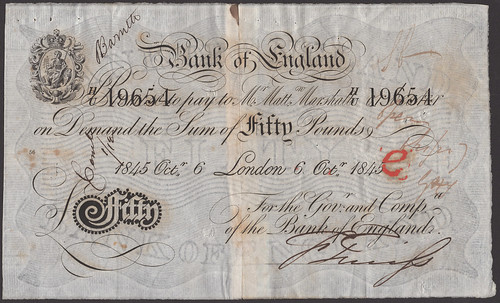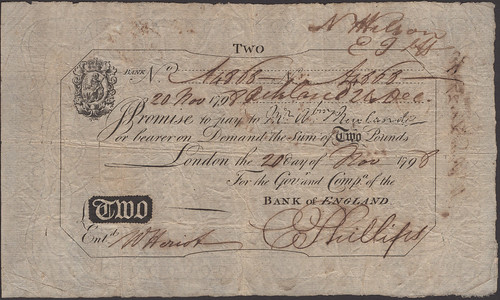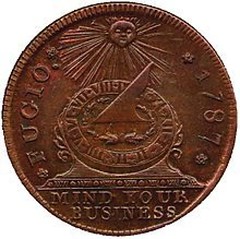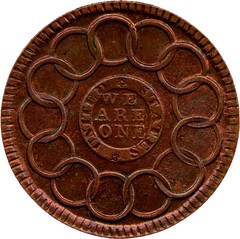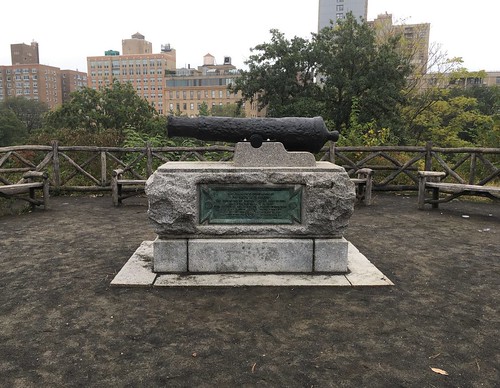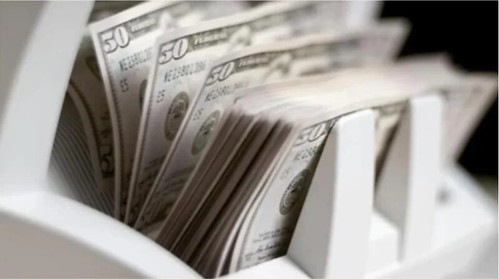
Visit our NBS Sponsors




About UsThe Numismatic Bibliomania Society is a non-profit association devoted to the study and enjoyment of numismatic literature. For more information please see our web site at coinbooks.org SubscriptionsThose wishing to become new E-Sylum subscribers (or wishing to Unsubscribe) can go to the following web page link MembershipThere is a membership application available on the web site Membership Application To join, print the application and return it with your check to the address printed on the application. Print/Digital membership is $40 to addresses in the U.S., and $60 elsewhere. A digital-only membership is available for $25. For those without web access, write to: Jeff Dickerson, Treasurer AsylumFor Asylum mailing address changes and other membership questions, contact Jeff at this email address: treasurer@coinbooks.org SubmissionsTo submit items for publication in The E-Sylum, write to the Editor at this address: whomren@gmail.com BUY THE BOOK BEFORE THE COIN |
- WAYNE'S WORDS: THE E-SYLUM OCTOBER 1, 2023
- APHRODITE AUCTION 14 LITERATURE SELECTIONS
- NEW BOOK: COINS OF THE PTOLEMAIC EMPIRE, PART 2
- NEW BOOK: BRITISH CELTIC COINS
- NEW BOOK: MORGAN AND PEACE DOLLARS 5TH ED
- NEW BOOK: THE GERMAN BANKNOTES, 23RD ED
- BOOK REVIEW: SAFEGUARDING HISTORY
- ANA LIBRARY ADDS FIRST EDITION VAN LOON
- NNP ADDS BATTY'S COPPER COINAGE
- VIDEO: MARK BORCKARDT AND PENNY WISE
- HARVARD MUSICAL CLUBS
- NOTES FROM E-SYLUM READERS: OCTOBER 1, 2023
- RESEARCHING NEW JERSEY COPPERS
- 2023 DEREK ALLEN PRIZE WINNER JOE CRIBB
- VOCABULARY TERM: OFF CENTER
- WILLIAM HENRY RUE (1911-1972)
- MORE ON THE FRANK S. ROBINSON SALE 122
- MDC OCTOBER 2023 FRENCH COLLECTION SELECTIONS
- NUMISMATIC NUGGETS: OCTOBER 1, 2023
- COINS OF THE FALL OF ROME
- JERSEY COIN HOARD RESEARCH MONEY ALLOCATED
- LONDON BRIDGE HERO RECIEVES QUEEN'S MEDAL
- NOONAN'S OFFERS RARE BANK OF ENGLAND NOTES
- ARAMCO COUPONS
- PENNY PEEVE
- COLLECTING NAZI MEMORABILIA
- THE LEGEND OF NEW YORK'S HELL GATE TREASURE
- LOOSE CHANGE: OCTOBER 1, 2023
- WOMAN CAUGHT SMUGGLING GOLD COINS
- FEATURED WEBSITE: CARNATION, LLC
Content presented in The E-Sylum is not necessarily researched or independently fact-checked, and views expressed do not necessarily represent those of the Numismatic Bibliomania Society.
WAYNE'S WORDS: THE E-SYLUM OCTOBER 1, 2023
 Thank you for reading The E-Sylum. If you enjoy it, please send me the email addresses of friends you think may enjoy it as well and I'll send them a subscription. Contact me at whomren@gmail.com anytime regarding your subscription, or questions, comments or suggestions about our content.
Thank you for reading The E-Sylum. If you enjoy it, please send me the email addresses of friends you think may enjoy it as well and I'll send them a subscription. Contact me at whomren@gmail.com anytime regarding your subscription, or questions, comments or suggestions about our content.
This week we open with a numismatic literature sale, four new books, a book review, ANA Library news, updates from the Newman Numismatic Portal, and more.
Other topics this week include Harvard Musical Clubs, New Jersey coppers, Joe Cribb, auction previews, off-center coins, rare Bank of England notes, Aramco coupons, and New York's Hell Gate treasure.
To learn more about coins of the Ptolemaic Empire, British Celtic coins, Morgan and Peace Dollars, Ken Rendell, Gerard Van Loon, Jim Groninger, Dale Seppa, Catherine Bullowa, Batty's Copper Coinage, the Protestants Supported Medal, ventriloquist Joseph Askins, the Queen's Medal for Gallantry, and the coin collection of Sir Arthur Conan Doyle, read on. Have a great week, everyone!
Wayne Homren
Editor, The E-Sylum
APHRODITE AUCTION 14 LITERATURE SELECTIONS
Andrew Pollack alerted me to the books and auction catalog section of the upcoming sale by Aphrodite of Germany. The literature sections close October 2. Thank you. Here are some selected lots. -Editor
Lot 1717: AA.VV. Spatantike und fruhes Christentum. Frankfurt, 1984 Legatura editoriale, pp. 698, ill.
To read the complete lot description, see:
https://www.biddr.com/auctions/aphroditeartcoins/browse?a=3889&l=4534153
Lot 1718: A.A.V.V. - La collezione di monete mantovane dell'Ermitage. Milano, 1995. Pp. 275, tavole e ill. nel testo a colori e b\n. ril. ed. buono stato, importante documentazione.
To read the complete lot description, see:
https://www.biddr.com/auctions/aphroditeartcoins/browse?a=3889&l=4534154
Lot 1721: A.A.V.V. - Sirmium VIII. Rome – Belgrade, 1978. Pp. 205, tavv. 34, + ill. nel testo. ril. ed. buono stato, importanti lavori di numismatica del IV secolo, compreso imitazioni romane di Costantino.
To read the complete lot description, see:
https://www.biddr.com/auctions/aphroditeartcoins/browse?a=3889&l=4534157
Lot 1726: AA.VV. - La moneta greca e romana. Roma, 2000. pp. 161, tavv. 43, + tavv. nel testo a colori e b\n. ril ed rigida tela, ottimo stato importante volume con ottimi artcoli scritti da grandi studiosi di numismatica antica.
To read the complete lot description, see:
iddr.com/auctions/aphroditeartcoins/browse?a=3889&l=4534162
Lot 1735: A.A.V.V. Trésors monétaires. Trésors de l'Ouest de la France. Tome XXII -2005/2006. Paris, 2007. Pp.327 + tavv.46, ill. nel testo. Ril.ed. Buono stato ottima documentazione di monete romane del tesoro di Pedernec composto da 2260 antoniniani del III secolo.
To read the complete lot description, see:
https://www.biddr.com/auctions/aphroditeartcoins/browse?a=3889&l=4534171
Lot 1761: BELLESIA L. - Le monete di Solferino. Serravalle, 2020. Pp. 74, tavv. e ill. nel testo a colori e b\n. ril. ed. ottimo stato, ottimo lavoro
To read the complete lot description, see:
https://www.biddr.com/auctions/aphroditeartcoins/browse?a=3889&l=4534197
To browse the sale, see:
https://www.biddr.com/auctions/aphroditeartcoins/browse?a=3889&c=82885
NEW BOOK: COINS OF THE PTOLEMAIC EMPIRE, PART 2
The American Numismatic Society has published the long-awaited three-volume follow-up to Coins of the Ptolemaic Empire by Catharine C. Lorber. The books are being printed and pre-orders are now being accepted. -Editor
Coins of the Ptolemaic Empire, Part 2: Ptolemy V through Cleopatra VII (3 vols.)
Coins of the Ptolemaic Empire, Part II, by Catharine C. Lorber, is the long-anticipated second half of the Coins of the Ptolemaic Empire (CPE) project featuring the coins struck by Ptolemy V–Cleopatra VII. As with Part 1, Lorber essentially rewrites the sections on these rulers in J. N. Svoronos' classic, but now much out-of-date, Ta Nomismata tou Kratous ton Ptolemaion (1904). The body of coinage catalogued by Svoronos is enlarged by hundreds of additional emissions in precious metal and bronze, recorded from subsequent scholarship, from hoards, from commercial sources, and from private collections. Lorber's attributions, dates, and interpretations rest on numismatic research conducted after Svoronos, or on the latest archaeological and hoard information. She also provides extensive historical and numismatic introductions that give the coins deeper context and meaning. Available as a 3-volume set with extensive historical introductions, catalogues, and plates for precious metal and bronze coinage.
ANS Members receive a 30% discount. Use your membership code during checkout.
Books will ship to customers in late October.
ABOUT THE AUTHOR
Catharine Lorber holds a B.A. in Classical Greek from UCLA. She spent nearly 40 years as a cataloguer in commercial numismatics, from the early 1970s until her retirement in 2009. As an independent researcher, she specialized in the publication of coin hoards as well as studies pertaining to North Greek, Thessalian, Judaean, Cappadocian, Seleucid, and Ptolemaic coinages. Her most important contribution in the Seleucid field, in collaboration with Arthur Houghton, was Seleucid Coins, A Comprehensive Catalogue (Part I, 2002; Part II, 2008, with Oliver Hoover as a third coauthor). Her book credits also include Amphipolis: The Civic Coinage in Silver and Gold (1990) and Yehud: A Die Study and Classification of the Provincial Silver Coinage of Judah (2023), with Haim Gitler and Jean-Philippe Fontanille. Since 2000 Lorber has published more than 50 papers and book chapters treating Ptolemaic coinage, Ptolemaic iconography, and the role of coinage in the economy of Lagid Egypt.
ISBN (United States) 978-0-89722-372-0 (available only as a 3-volume set)
ISBN (rest of world) 978-0-89722-402-4 (available only as a 3-volume set)
Hardcover (Historical Introduction): xix + 399 pp., A4, 92 b/w figs.
Hardcover (Precious-Metal Catalogue and Plates): xi + 282 pp., A4, 61 b/w plates
Hardcover (Bronze Catalogue and Plates): ix + 143 pp., A4, 18 b/w plates
For more information, or to order, see:
US: Coins of the Ptolemaic Empire, Part II
(https://www.isdistribution.com/BookDetail.aspx?aId=168759)
INTERNATIONAL: Coins of the Ptolemaic Empire, Part 2: Ptolemy V through Cleopatra VII
(https://www.brepols.net/products/IS-9780897224024-1)
To read the earlier E-Sylum article, see:
NEW BOOK: COINS OF THE PTOLEMAIC EMPIRE
(https://www.coinbooks.org/v21/esylum_v21n26a03.html)
NEW BOOK: BRITISH CELTIC COINS
SPINK has published a new book by Tim Wright on British Celtic coins. -Editor
British Celtic Coins: Art or Imitation?
Tim Wright
£30.00
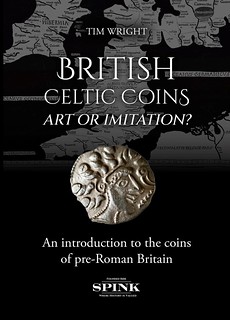 The peoples of pre-Roman Britain remain an enigma. Our perceptions are shaped by two narratives, that of contemporary Roman colonists and more recent Celtic nationalists, who vilify and glorify them in equal measure. The more we learn, the less we know with certainty: should they be described as ‘Celtic peoples', were they organised into the ‘tribes' that later formed Roman administrative districts (civitas) and, beyond a few famous names like Cunobelinus (Shakespeare's Cymbeline), were they led by ‘kings' or ‘chieftains'?
The peoples of pre-Roman Britain remain an enigma. Our perceptions are shaped by two narratives, that of contemporary Roman colonists and more recent Celtic nationalists, who vilify and glorify them in equal measure. The more we learn, the less we know with certainty: should they be described as ‘Celtic peoples', were they organised into the ‘tribes' that later formed Roman administrative districts (civitas) and, beyond a few famous names like Cunobelinus (Shakespeare's Cymbeline), were they led by ‘kings' or ‘chieftains'?
The coins from this period are no less controversial. Britain was a late adopter of coinage, initially importing coins from the Gallo-Belgic continent and then copying their Macedonian-inspired prototypes. Britain also produced them for longer than the continent, latterly incorporating themes and imagery from Rome. These bookends of external influence have led some to dismiss the coins of pre-Roman Britain (and indeed ‘Celtic' coins generally) as inferior. The most compelling counter to this is the coins themselves, explored through the theme of Art or Imitation? What we find is extraordinary variety and originality, that makes a powerful case for their collection and study.
Hardback. 144 pages.
Tim Wright is a collector of ancient coins. His initial interest was in the Greek coins of Magna Graecia and Republican Rome, but he is now focused on the coins of pre-Roman Britain.
For more information, or to order, see:
British Celtic Coins: Art or Imitation? | Tim Wright
(https://spinkbooks.com/products/british-celtic-coins-art-or-imitation-tim-wright/)
NEW BOOK: MORGAN AND PEACE DOLLARS 5TH ED
A new 5th edition of the Comprehensive Catalog and Encyclopedia of Morgan and Peace Dollars is now available. Here's the announcement. -Editor
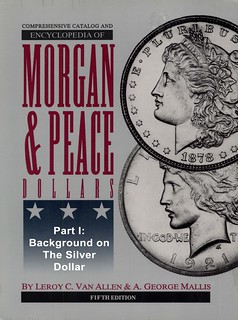 This is to announce parts I, II and III of the 5th Edition of the Comprehensive Catalog and Encyclopedia of Morgan and Peace Dollars is now available on Amazon Kindle. It was edited by Michael S. Fey, Ph.D. and provides references and links to annual supplemental discoveries, and so much more.
This is to announce parts I, II and III of the 5th Edition of the Comprehensive Catalog and Encyclopedia of Morgan and Peace Dollars is now available on Amazon Kindle. It was edited by Michael S. Fey, Ph.D. and provides references and links to annual supplemental discoveries, and so much more.
This landmark reference includes information on availability, populations, grading, history, design development, errors, varieties, Government Services Administration (GSA) and Redfield hoards, preservation, storage, photography and counterfeiting of Morgan and Peace silver dollars. Each part is priced at only $9.95. Now, instead of carrying around this heavy reference work, any dealer, collector, investor or interested party can carry it on their phone or on their home computer.
This now opens, for the first time to the general public, inexpensive and detailed information from Leroy Van Allen and A. George Mallis of just about everything you might want to know about Morgan and Peace silver dollars. It also brings this vital information into the digital age and into the future where it can potentially engage hundreds of thousands of U.S. Mint buyers as well as serious collectors.
Here's more information from the Amazon site. -Editor
Every dealer, collector and investor interested in Morgan and Peace silver dollars should have a copy of this ground-breaking reference book! Over 50,000 sold. Leroy C. Van Allen and A. George Mallis are considered to be the fathers of Morgan and Peace silver dollars. This opus, now in its 5th edition, is separated into three (3) parts (a first as an e-publication!). It has everything you would ever need to know about Morgan and Peace silver dollars.
This reference is more than 500 pages and packed full of information. It is presented in 3 parts.
Part 1 provides a history, background and method of manufacture and minting of Morgan and Peace silver dollars. This is detailed with numerous charts, diagrams, pictures and literature references.
Part 2 is dedicated solely to Morgan dollars to include definitions of the obverse and reverse designs used in minting from 1878 to 1921, proofs, patterns, and significant varieties and striking errors and die rotations, as well as detailed listings of condition analysis and die varieties by Van Allen-Mallis (VAM) number. Copious descriptions and pictures are given to allow the reader to determine which variety they might have.
Part 3 is dedicated solely to Peace silver dollars to include definitions of the obverse and reverse designs used in minting from 1921 to 1935. Proofs and significant varieties and striking errors and die rotations as well as detailed listings of condition analysis and die varieties by Van Allen-Mallis (VAM) number. Copious descriptions and pictures are given to allow the reader to determine which variety they might have. Also included are chapters on detecting counterfeits, information on preservation and storage, and photographing silver dollars.
For more information, or to order, see:
Comprehensive Catalog and Encyclopedia or Morgan & Peace Silver Dollars-Part1. Background on the Silver Dollar (Comprehensive Catalog and Encyclopedia of Morgan and Peace Silver Dollars (Parts 1-3))
(https://www.amazon.com/Comprehensive-Catalog-Encyclopedia-Dollars-Part1-Background-ebook/dp/B0C8F4NQD2/ref=sr_1_4)
Comprehensive Catalog and Encyclopedia of Morgan & Peace Silver Dollars--Part II Morgan Silver Dollars (Comprehensive Catalog and Encyclopedia of Morgan and Peace Silver Dollars (Parts 1-3) Book 2)
(https://www.amazon.com/Comprehensive-Catalog-Encyclopedia-Dollars-Part-Dollars-ebook/dp/B0CGW3D837/ref=sr_1_3)
Comprehensive Catalog and Encyclopedia of Morgan & Peace Dollars--Part III The Peace Silver Dollar (Comprehensive Catalog and Encyclopedia of Morgan and Peace Silver Dollars (Parts 1-3))
(https://www.amazon.com/Comprehensive-Catalog-Encyclopedia-Dollars-Part-Dollars-ebook/dp/B0CJT12X5Y/ref=sr_1_5)
THE BOOK BAZARRE
NEW BOOK: THE GERMAN BANKNOTES, 23RD ED
There's a new edition of the book on German banknotes by Hans-Ludwig Grabowski. Here's a Google-translated description from the publisher's website. -Editor
The German banknotes from 1871
Hans Ludwig Grabowski
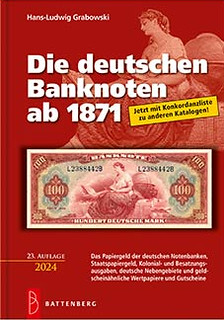 The paper money of the German central banks, government paper money, colonial and occupation issues, German tributaries and banknote-like securities and vouchers
The paper money of the German central banks, government paper money, colonial and occupation issues, German tributaries and banknote-like securities and vouchers
ISBN: 978-3-86646-224-3
Edition: 23rd edition 2023/2024
Dimensions: 14.8 x 21 cm
Type of figures: colored throughout
Type of cover: Hardcover
Number of pages: approx. 864
The completely colored, current standard work on German banknotes from the founding of the German Empire in 1871 to the present day of the Euro, divided into historical eras: Empire, Weimar Republic
, Third Reich
, Allied Occupation, GDR, Federal Republic and subsidiary regions. In addition to the notes of the German central banks (including the state central banks), government paper money, colonial and occupation expenditure, banknote-like securities and vouchers as well as occupation expenditure from both world wars and military money were included. All areas are cataloged with their own number ranges and are currently assessed.
The catalog includes:
- German banknotes and government paper money
- German Empire 1871–1918
-
Weimar Republic
1918–1933 - German / Greater German Empire 1933–1945
- Allied occupation 1945–1948
- German Democratic Republic 1949–1990
- Federal Republic of Germany 1949–1999
- European Monetary Community from 2002
Sub-areas:
- State emergency expenditure
- German state and private central banks 1871–1930
- Banknotes from the German colonies
- German foreign banks (Argentina, China, Mexico)
- German military and occupation expenditure as well as ghetto and prison money
- Securities similar to paper money (conversion cash vouchers, tax vouchers)
- Vouchers similar to paper money (WHW vouchers)
- German tributaries (Occupied Rhineland, Danzig, Memel area, Saar area)
For more information, or to order, see:
Die deutschen Banknoten ab 1871
(https://www.battenberg-gietl.de/produkt/die-deutschen-banknoten-ab-1871)
BOOK REVIEW: SAFEGUARDING HISTORY
Here's another review of Ken Rendell's memoir, Safeguarding History, this time my historian Doris Kearns Goodwin. -Editor
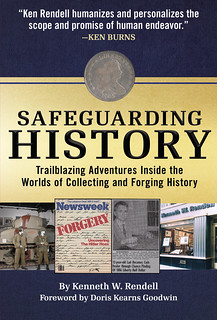 Whitman Publishing will release Safeguarding History, the memoirs of internationally famous artifacts collector and dealer Kenneth W. Rendell. Subtitled Trailblazing Adventures Inside the Worlds of Collecting and Forging History, the 328-page book shares Rendell's business philosophy as well as his life story, and shows why he's known as the
Whitman Publishing will release Safeguarding History, the memoirs of internationally famous artifacts collector and dealer Kenneth W. Rendell. Subtitled Trailblazing Adventures Inside the Worlds of Collecting and Forging History, the 328-page book shares Rendell's business philosophy as well as his life story, and shows why he's known as the Indiana Jones
of the collecting world.
Among coin collectors, Rendell is noted as a founding member of the Rittenhouse Society, a contemporary of Q. David Bowers and Kenneth Bressett. He was a prodigy coin dealer while in his teens in the 1950s, selling colonial coppers to such luminaries as Ambassador R. Henry Norweb, and a contributor to the Red Book at the age of sixteen.
Pulitzer Prize–winning historian Doris Kearns Goodwin wrote the foreword to Safeguarding History. Here, she shares her thoughts on Kenneth Rendell and his autobiography:
This eloquent, captivating, and moving memoir takes the reader on the journey of an eleven-year-old boy, Kenneth Rendell, growing up in a poor neighborhood, who, with the sale of a single 1806 half dollar, experiences the magic of collecting and goes on to become the world's most notable collector, dealer, and appraiser in historical letters, documents, and artifacts.
And what a journey it is! We share his excitement when, at the age of sixteen, he meets a dealer in presidential documents and trades his entire British coin collection for a group of presidential letters. While old coins were great historical artifacts, he fell in love with handwritten letters that provide a window into the hopes and dreams—the very soul—of figures who have shaped the destiny of our country. Collecting became an emotional pursuit as well as an intellectual one.
This eloquent, captivating, and moving memoir takes the reader on the journey of an eleven-year-old boy, Kenneth Rendell, growing up in a poor neighborhood, who, with the sale of a single 1806 half dollar, experiences the magic of collecting and goes on to become the world's most notable collector, dealer, and appraiser in historical letters, documents, and artifacts.
And what a journey it is! We share his excitement when, at the age of sixteen, he meets a dealer in presidential documents and trades his entire British coin collection for a group of presidential letters. While old coins were great historical artifacts, he fell in love with handwritten letters that provide a window into the hopes and dreams—the very soul—of figures who have shaped the destiny of our country. Collecting became an emotional pursuit as well as an intellectual one.
In an essay on the nature of collectors, the philosopher Walter Benjamin argues that collecting allows children a small corner where they can order a disordered world. For the teenage boy whose father fell into bankruptcy and committed suicide, collecting provided a sanctuary where he could be on his own, free from the pandemonium of his household.
He had found his vocation, the arena in which he felt he was most vitally alive, when, as the philosopher William James suggested, a voice inside speaks and says, ‘This is the real me!' And how lucky we are to share in his passion, to savor the moments he comes upon breathtaking documents and letters—manuscript pages written by Henry David Thoreau, a George Washington letter discovered in a New Hampshire auction, a Thomas Jefferson letter about the future of slavery. (This letter, which Rendell bought in the early 1970s for $20,000—a princely sum when still in his twenties—and then immediately sold to Malcolm Forbes for $25,000, was eventually sold again in the 1990s after Forbes died for $700,000.)
Over the decades, as Rendell's collecting interests expand from modern to ancient times, from North America to every continent in the world, we meet a cast of intriguing characters and are privy to an inside look at the complex world of collecting—a world filled with adventures, mysteries, sensational hoaxes, thefts, and even murders.
Self-taught in foreign languages, culture, and history, Rendell becomes an expert in authenticating handwritten materials and documents and is called upon as a special consultant in a number of high-profile cases that read like fast-moving detective stories.
A master storyteller, with keen insight into the motivations of people, Rendell brings the reader into the drama of uncovering the biggest hoaxes in modern literary times—the discovery of sixty volumes of a purported Hitler diary; the dramatic unearthing of a diary by Jack the Ripper, promising to reveal the mind of one of the most notorious serial killers; the sensational Mormon White Salamander letter and the related murders.
We follow Rendell's painstaking work that revealed the forgeries—his examination of the individual characteristics of handwriting and the known habits of the writer. A uniformity in the writing and the ink used would suggest a diary written in a short period rather than over a number of years. He knew how to date the ink, the paper, the bindings, the use of words not yet in use in colloquial language. In Jack the Ripper's supposed 1880s diary, the use of the phrase ‘one off,' which was not in common use until 1925, was a clear warning signal.
Rendell's role in debunking these multi-million-dollar hoaxes landed him in the front pages of newspapers and magazines. In print and on television, he was dubbed the Indiana Jones of the collecting world.
In each case, other independent experts had authenticated the material, and a great deal of time and money had been spent in publicity and publishing rights. Rendell concluded that publishers had seen only what they wanted to see—beating the competition, fame and fortune.
There are additional compelling stories behind Rendell's creation of a 10,000-book library for Bill and Melinda Gates, and the building of the most comprehensive World War II collection that follows the war from beginning to end through tens of thousands of documents and artifacts, including Hitler's writings, Nazi party banners, anti-Semitic broadsides, Resistance newspapers, Churchill's propaganda posters and manuscripts, a first edition of Anne Frank's diary, and the surrender documents.
In the end, however, this compelling memoir is the story of a boy who rises above adversity with ambition, a curiosity that allows him to keep learning his entire life, a powerful work ethic, an ability to think outside the box, and, most importantly, a recognition that reputation and character are the true driving forces of success.
Doris Kearns Goodwin is a historian and presidential biographer, international keynote speaker, and New York Times #1 best-selling author. Her book No Ordinary Time: Franklin and Eleanor Roosevelt: The Home Front in World War II earned the Pulitzer Prize in history. She is the author of other bestsellers including Wait Till Next Year, The Fitzgeralds and the Kennedys (adapted into an award-winning television miniseries), and Lyndon Johnson and the American Dream. President Barack Obama named her Abraham Lincoln biography Team of Rivals as essential reading for the Oval Office. Goodwin is a consultant to PBS and the History Channel, and executive producer of Pastime Productions.
About Kenneth W. Rendell
Kenneth W. Rendell, founder and director of the International Museum of World War II, has been a collector and dealer since the 1950s in rare coins, historical letters, documents, and other historical artifacts. His rare-manuscript business, with offices in Boston and a gallery in New York City, encompasses all areas including politics, the law, the military, art, literature, music, science, and others. He has authored the standard reference books in the field, including History Comes to Life. For Rendell, the field of forgeries and journalistic hoaxes is another major interest. He debunked the infamous Hitler diaries
on behalf of Newsweek Magazine in 1983, and then headed the investigation for Stern Magazine into how the hoax had been perpetrated. For Time Warner he proved the diary of Jack the Ripper was a hoax, and he has been involved in every major forgery case in recent decades. He is the author of Forging History, the standard reference work on the subject. As an expert witness, Rendell has appeared in criminal trials where his expertise and testimony would make a difference, including the trial of the Mormon White Salamander murders. He received the Justice Department's Distinguished Service Award for his work leading to convictions for thefts from the National Archives and the Library of Congress. He also won the only two Tax Court cases deciding the value of archives without compromise: one for the Internal Revenue Service (the Otto Kerner Papers), the other for the taxpayer (the Northern Pacific Railroad). Another major interest of Rendell's is Western American history. His extensive collection in this field was the basis of his book The Western Pursuit of the American Dream, which the New York Times said succeeds in giving a sense of the struggle to tame the gorgeous wilderness that stretched beyond the tidy civilizations of the east. . . . It's worth spending time with.
Safeguarding History: Trailblazing Adventures Inside the Worlds of Collecting and Forging History
By Kenneth W. Rendell; foreword by Doris Kearns Goodwin.
328 pages, full color.
Hardcover with dustjacket.
ISBN 0794850499.
Retail $24.95.
To read the earlier E-Sylum articles, see:
NEW BOOK: SAFEGUARDING HISTORY
(https://www.coinbooks.org/v26/esylum_v26n31a06.html)
BOOK REVIEW: SAFEGUARDING HISTORY
(https://www.coinbooks.org/v26/esylum_v26n39a07.html)
ANA LIBRARY ADDS FIRST EDITION VAN LOON
The ANA library has acquired a copy of the classic Van Loon work on Dutch medals. -Editor
 The American Numismatic Association (ANA) Dwight N. Manley Library is the world's largest numismatic lending library. It is host to more than 128,000 books, auction catalogs, periodicals, DVDs and more. Another addition was made to the library during the ANA President's Reception, which took place during the World's Fair of Money® in Pittsburgh. During the event, Margaret Groninger donated her late-husband James G. Groninger's set of Gerard Van Loon's "Beschryving der Nederlandsche Historipenningen" to the ANA library.
The American Numismatic Association (ANA) Dwight N. Manley Library is the world's largest numismatic lending library. It is host to more than 128,000 books, auction catalogs, periodicals, DVDs and more. Another addition was made to the library during the ANA President's Reception, which took place during the World's Fair of Money® in Pittsburgh. During the event, Margaret Groninger donated her late-husband James G. Groninger's set of Gerard Van Loon's "Beschryving der Nederlandsche Historipenningen" to the ANA library.
Although published in the first half of the 18th century, the first edition of this four volume reference remains a standard for researchers and collectors of Dutch medals. This set covers commemorative medals produced by The Netherlands during the period of 1555 through 1716 and includes a written description of each medal, engraved images, and commentary by Van Loon. Also included with this donation is an English translation of the Dutch text by Robert Turfboer.
"Jim Groninger was a consummate student of numismatics from the time he was a paper boy for the Pittsburgh Press," shared Ms. Groninger. "This sparked his interest in collecting U.S. coins and later broadened to collecting foreign coins, especially those relating to his Dutch heritage and links to Groningen. The study of numismatics was a lifelong passion of Jim's and he would have been delighted to know that his work will now be available for posterity."
At a local club meeting a fellow member once told me, "You know everybody in this hobby." That's not quite true, but it sure does seem that way. I've met Doug Mudd of course, but through the Pennsylvania Association of Numismatists I also knew Jim and Margaret Groninger, and through Jim I'd met Bob Turfboer, who co-authored one of my favorite numismatic books, Tempus in Nummis.
Jim was a dedicated numismatist, and helped out with the 1989 ANA convention. He loved his Van Loon dearly, and would have been quite pleased to see it given to the ANA. I wasn't aware of this event in advance; I would have liked to have been there for the presentation. -Editor
To read earlier E-Sylum articles, see:
NEW BOOK: MEDALLIC HISTORY OF THE LOW COUNTRIES
(https://www.coinbooks.org/v23/esylum_v23n51a03.html)
BOOK REVIEW: VAN LOON ENGLISH TRANSLATION
(https://www.coinbooks.org/v24/esylum_v24n26a07.html)
For more information on the ANA's Dwight N. Manley Numismatic Library, see:
Dwight N. Manley Numismatic Library
(https://www.money.org/library/)
NNP ADDS BATTY'S COPPER COINAGE
The latest addition to the Newman Numismatic Portal is Batty's Catalogue of the Copper Coinage of Great Britain, Ireland, British Isles and Colonies. Project Coordinator Len Augsburger provided the following report. -Editor
Newman Portal Scans D. T. Batty's Catalogue of Copper Coinage
Recently scanned at the American Numismatic Society is Batty's Catalogue of the Copper Coinage of Great Britain, Ireland, British Isles and Colonies. This four-volume work was originally issued in parts, between 1868 and 1898. The October 1876 American Journal of Numismatics reported Mr. D. T. Batty…is now publishing a valuable work…It is compiled from various sources, but especially from the author's own collection of fifteen thousand varieties…
Volume one (nos. 1-2973) covers penny and halfpenny tokens, volume two (nos. 2974-4251) continues with halfpenny and farthing tokens, while volume three (nos. 1-6850) includes regal copper coins. Volume four, published by George Frederick Lawrence after Batty's death, includes an appendix to the previous volumes (nos. 6851-8304) as well as coverage of the colonial issues (nos. 1-2133, primarily Canada). The ANS library further includes a typescript index to the first two Batty volumes.
Sets of Batty are scarce. The Bass sale included a four-volume set, of which vols. 1-3 were large paper copies. This lot was acquired by Bill Burd. Charles Davis further offered a four-volume set in original cloth in the summer 1991 Asylum. A quick check of abebooks.com reveals only print-on-demand reprint versions, while the UK bookseller Galata offers a four-volume set, with c. 1900 library binding, for £540.
Image: cover of first installment of the D. T. Batty Catalogue
Link to Batty Catalogue (Clain-Stefanelli 13860) on Newman Portal:
https://nnp.wustl.edu/library/booksbyauthor/551260
VIDEO: MARK BORCKARDT AND PENNY WISE
The David Lisot Video Library on the Newman Numismatic Portal can be found at:
https://nnp.wustl.edu/library/multimediadetail/522852
We highlight one of his videos each week in The E-Sylum. Here's one from 2007 with Mark Borckardt speaking about his large cent research in the pages of Penny Wise. -Editor
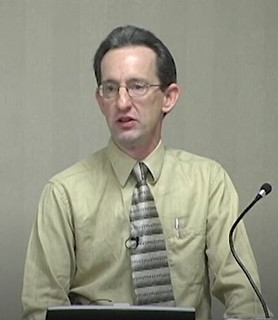 Longtime Early American Coppers member shares his research into the various contributors to the publication "Penny Wise." These anecdotes will amuse and entertain you about some of the hobby's more literate personalities. Speaker(s): Mark Borckardt.
Longtime Early American Coppers member shares his research into the various contributors to the publication "Penny Wise." These anecdotes will amuse and entertain you about some of the hobby's more literate personalities. Speaker(s): Mark Borckardt.
To watch the complete video, see:
https://nnp.wustl.edu/library/book/560166
HARVARD MUSICAL CLUBS
Jonathan Brecher submitted these notes and images on Harvard Banjo Club medals. Thank you! For reference I've pictured Dave Schenkman's piece at the top of the article - the others are Jonathan's. -Editor
 I have a Harvard Banjo Club piece similar to Dave Schenkman's example. Rulau cites the Kirtley sale in calling it a splasher. I don't think that's the right term. I also don't think I'd call it a die trial. On the other hand I'm not comfortable calling it a finished piece either. If you look at Dave's piece, the edges are irregularly trimmed. They are irregular on my pieces as well — but differently irregular. That speaks to me as not a finished production, whatever term you want to apply to these pieces.
I have a Harvard Banjo Club piece similar to Dave Schenkman's example. Rulau cites the Kirtley sale in calling it a splasher. I don't think that's the right term. I also don't think I'd call it a die trial. On the other hand I'm not comfortable calling it a finished piece either. If you look at Dave's piece, the edges are irregularly trimmed. They are irregular on my pieces as well — but differently irregular. That speaks to me as not a finished production, whatever term you want to apply to these pieces.
Anne Bentley's article on Harvard medals in the September 2020 MCA Advisory has a photo of a different Harvard Banjo Club medal that is silver plated and with a different design.
I purchased my example with several other uniface Harvard medals for the Harvard Advocate, the Harvard Mandolin Club, and the Harvard Musical Club. The Harvard Musical Club medal does exist with a struck reverse (Storer 906), which supports the idea that these are not finished pieces. There are other struck medals for The Harvard Advocate (Storer 878-879), but this one is from a different die than any other example I could find (this one has a smaller Pegasus). I haven't found struck examples of Harvard Banjo Club or Harvard Mandolin Club medals.
To read the earlier E-Sylum article, see:
WAYNE'S NUMISMATIC DIARY: SEPTEMBER 24, 2023 : Banjos and Dimes
(https://www.coinbooks.org/v26/esylum_v26n39a25.html)
NOTES FROM E-SYLUM READERS: OCTOBER 1, 2023
On Originals vs Copies
Earlier Pete Smith asked, "Is a typewritten original letter worth any more than a letter printed with multiple copies or a photocopy?"
Dave Steine writes:

"For me, original handwritten or typed letters are much more valuable than copies. I especially like letters on original letterhead."
Me, too. I was never classy enough to get myself a letterhead. My physical correspondence was printed on plain printer paper. Now my correspondence is pretty much digital only. -Editor
To read the earlier E-Sylum article, see:
ORIGINALS, COPIES, AND TYPEWRITTEN LETTERS
(https://www.coinbooks.org/v26/esylum_v26n38a17.html)
Digitizing Literature of Ancient Numismatics
Jackie L. of
Minneapolis, MN writes:
"I was very happy to read the announcement in the September 24, 2023, E-Sylum edition, regarding the Newman Portal and S&S Library, LLC's Team to Digitize Literature of Ancient Numismatics.
As someone who mainly collects ancient coins from various cultures, this is going to be a most welcomed addition to the already wonderful Newman Numismatic Portal. It can be difficult to find specialized reading materials on ancient coinage beyond Rome and Greece. I have been focusing on Central Asian cultures lately and the latter is especially difficult to find authoritative literature that's published in English."
Yes, this will be a great expansion for the portal, and will be helpful to many people in many ways. Thanks and good luck to all involved. -Editor
To read the earlier E-Sylum article, see:
NNP TO DIGITIZE LITERATURE OF ANCIENT NUMISMATICS
(https://www.coinbooks.org/v26/esylum_v26n39a09.html)
On Damaged Cash in the Philippines
Dennis Tucker writes:
"The article VIETNAM'S DAMAGED MONEY COLLECTORS
reminded me of an experience in the Philippines in July 2022. I went to a Western Union office in one of the big malls in Bonifacio Global City, the financial business district in Taguig in Metro Manila. I was exchanging a small amount of U.S. cash, a couple hundred dollars, for Philippine pesos. I was surprised when two of my $20 Federal Reserve Notes were rejected. The cashier politely and professionally pointed out that each of them had a tiny tear --- normal circulation wear, from my perspective, but I've since learned that any paper currency less than perfect runs the risk of being refused. If it's written on, stained, has a corner torn off, a small rip, etc., exchange offices won't run the risk of it being counterfeit. Take out whatever folding-cash you might have in your wallet or pocket at the moment. Is it flawless? Maybe, but probably not! Next time I'm abroad I'll only bring premium-quality Uncirculated cash."
Wow, that's harsh. Thanks for the story - a good warning for travelers to the Philippines. -Editor
To read the earlier E-Sylum article, see:
VIETNAM'S DAMAGED MONEY COLLECTORS
(https://www.coinbooks.org/v26/esylum_v26n39a26.html)
See also:
How Do Banks Dispose Of Damaged Currency?
(https://carnation-inc.com/blogs/money-handling-blog/how-do-banks-dispose-of-damaged-currency)
More on Dale Seppa
Eric Hodge writes:
"I read with great sadness about the death of Dale Seppa. Alfred Buonaguro's memorial was so well written and virtually every word exemplified my experience too. I never met Dale either but we communicated for a number of years on a number of subjects. It all started when I read Dale's plea for some auction catalogues to be searched. I was at the Fitzwilliam in Cambridge at the time so they were all to hand. I was able to do the searches and reported back to Dale. He was so pleased even though I found nothing, because to Dale that was a positive in his never-ending searches. This search was on the RA/AR countermarks on Ecuadorian coins for the Galapagos. There were other searches that followed and much email communication. I shall miss that very much as I shall miss Dale."
To read the earlier E-Sylum articles, see:
DALE SEPPA (1940–2023)
(https://www.coinbooks.org/v26/esylum_v26n38a09.html)
NOTES FROM E-SYLUM READERS: SEPTEMBER 24, 2023 : On Dale Seppa and John Mussell
(https://www.coinbooks.org/v26/esylum_v26n39a12.html)
On the Coin Collection of Sir Arthur Conan Doyle
Website visitor Wendy Cushman writes:
"I found your articles online pertaining to Doyle's coin collection. My brother and I recently inherited my grandfather's coin collection and found two coins from the sale in 1968. We were looking for information about the coins and if you had any info on the value? Any information would be appreciated."
Nice find. Can anyone help? Does anyone have a copy of the Fall 1968 price list of Manfra, Tordella, & Brookes? -Editor
To read the earlier E-Sylum articles, see:
NOTES FROM E-SYLUM READERS: OCTOBER 12, 2014 : Query: Coins Pedigreed to Sir Arthur Conan Doyle Sought
(https://www.coinbooks.org/esylum_v17n42a07.html)
QUERY: CHRISTIE'S SIR ARTHUR CONAN DOYLE CATALOG SOUGHT
(https://www.coinbooks.org/esylum_v19n08a19.html)
MORE ON COINS COLLECTED BY SIR ARTHUR CONAN DOYLE
(https://coinbooks.org/esylum_v19n09a29.html)
Zinc Cent After Dryer Time
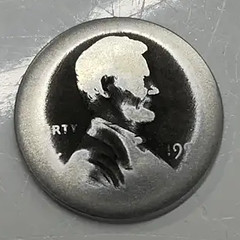 Gary Beals writes:
Gary Beals writes:
"Zinc cents are worthless! I recently learned what happens when these useless coins whirl around in a clothes dryer for several weeks."
Cool. Still sorta looks like Abe. -Editor
RESEARCHING NEW JERSEY COPPERS
Jeff Burke submitted this article on his careful research while acquiring a nice New Jersey copper for his collection. Thank you! -Editor
Researching My 1787 Maris 38-c New Jersey Colonial Copper Coin
It was my lucky night! New Jersey Numismatic Society members Bill Liatys and Michael Brooks surprised me by bringing an assortment of 40 to 50 raw and slabbed colonials to our April 2023 NJNS meeting for me to examine, ranging in grades from About Good to Mint State. It was the first time I had held a number of these specimens in my own hands since reading about them in the Red Book. They included colonials from VT, MA, CT, NY, NJ, and VA, as well as Rosa Americana 2 Pence and Half Pence, Machin's Mills, Mott Store Cards, Hibernia-Voce Populi coins, Talbot Allum & Lee examples, Nova Constellatio coppers, Woods Hibernia, Kentucky tokens, a Franklin Press Token, Washington pieces, North American tokens, and Bill's prized London Elephant token. It was fascinating to examine these specimens with my magnifying glass!
I've gained a wealth of knowledge about colonial coins from talking with Ray Williams and reading his column on colonial numismatics in The Numismatist, reading articles about New Jersey coppers in The C4 Newsletter, and being part of a New Jersey Coppers Facebook group. Holding those colonial coppers in my hands at our meeting and seeing Facebook posts of New Jersey copper varieties helped me decide to purchase my first New Jersey copper.
To further educate myself, before I started looking into specimens for sale, I conducted research on the Newman Numismatic Portal, examined Stack's Bowers and Heritage online auction records, and studied PCGS CoinFacts. I also reread sections pertaining to New Jersey coppers in the Whitman Encyclopedia of Colonial and Early American Coins, by Q. David Bowers.
Next, I examined 400 to 500 New Jersey coppers on various dealer websites, ranging in grade from About Good to Mint State. I kept returning to a 1787 38-c NGC XF 40 piece listed on Chris McCawley's Early Cents website (earlycents.com). After a phone conversation with Lucas Baldridge at Early Cents, the copper was mine!
 I chose this coin for its beautiful reddish-brown color and glossy surfaces. I also like that it is
struck slightly off center. I love this piece despite its planchet flaws and lack of a full date as
struck. It was described as a possible condition census level coin for the variety. I was also
attracted to the provenance, which includes Catherine Bullowa, Jon Hansen, and Donald Partrick
summarized on the Early Cents website as
I chose this coin for its beautiful reddish-brown color and glossy surfaces. I also like that it is
struck slightly off center. I love this piece despite its planchet flaws and lack of a full date as
struck. It was described as a possible condition census level coin for the variety. I was also
attracted to the provenance, which includes Catherine Bullowa, Jon Hansen, and Donald Partrick
summarized on the Early Cents website as Ex; Catherine Bullowa – Jon Hanson 3/1973 –
Donald G. Partrick Collection.
(As a side note: My wife Beth, and I had seen Catherine Bullowa's tables at the New York International Convention in January 2017, and I was impressed by her extensive inventory. I recognized Bullowa from photographs and articles I had read about her distinguished career as a professional numismatist. She was busy with the show at the time, while Beth and I moved on to see more bourse table offerings – but after her death later that year, I sincerely regretted not having struck up a conversation with her to learn about her journey as a coin dealer.)
 I was so excited when my new copper arrived in late August. It even came with the original 2x2
envelope from the Donald G. Partrick Collection. What a lovely piece! I couldn't be happier with
it!
I was so excited when my new copper arrived in late August. It even came with the original 2x2
envelope from the Donald G. Partrick Collection. What a lovely piece! I couldn't be happier with
it!
I am now researching auction records to learn more about the provenance of the piece. I also
looked it up on NGC Verification and then researched the variety in NGC Coin Explorer. Of
particular interest to me are articles about Catherine Bullowa and Donald Partrick that I found on
the Numismatic Bibliomania Society website. Two excellent articles, both by Pete Smith, are
Catherine Elias Bullowa-Moore (1919-2017),
in The E-Sylum: Volume 26, Number 23, June 4,
2023; and Donald G. Partrick (1926-2020),
in The E-Sylum: Volume 25, Number 29, July 17,
2022.
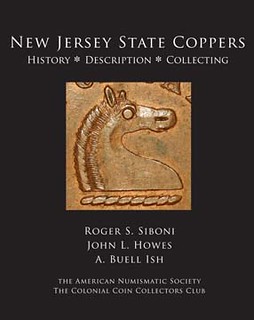 I was excited about Ray Williams loaning me his book on New Jersey State Coppers by Roger
Siboni, John Howes, and A. Buell Ish, to learn more about this coinage! It was a joy to spend
evenings reading this massive work. My favorite sections were
I was excited about Ray Williams loaning me his book on New Jersey State Coppers by Roger
Siboni, John Howes, and A. Buell Ish, to learn more about this coinage! It was a joy to spend
evenings reading this massive work. My favorite sections were Total Issue, Circulation, and
Modern Survival Estimates
(pp. 47-54), The Collectors and Their Collections
(pp. 57-81),
and Collecting Methodologies
(pp. 85-102). I plan to purchase Michael Demling's 2nd edition
of his New Jersey Coppers Attribution Guide if I decide to pursue more varieties of NJ coppers.
I am honored that my New Jersey copper was once in the coin cabinets of Donald Partridge and Catherine Bullowa. I plan to keep learning more about these figures and the coins in their collections. May their memories be cherished.
Note: Lucas Baldridge of Early Cents kindly gave me permission to use the obverse and reverse images of my coin from the Early Cents website to accompany this article.
To read the earlier E-Sylum articles, see:
DONALD G. PARTRICK (1926-2020)
(https://www.coinbooks.org/v25/esylum_v25n29a14.html)
CATHERINE ELIAS BULLOWA-MOORE (1919-2017)
(https://www.coinbooks.org/v26/esylum_v26n23a15.html)
2023 DEREK ALLEN PRIZE WINNER JOE CRIBB
The Derek Allen Prize is awarded annually by the British Academy in recognition of outstanding work by a scholar in musicology, numismatics, and Celtic studies, in rotation. This was a numismatic year, and the winner was author and researcher Joe Cribb. Congratulations! -Editor
History of the prize
The award commemorates Derek Fortrose Allen (1910–1975), elected a Fellow in 1963, who served from 1969 to 1973 as Secretary of the Academy and from then until his death as Treasurer. It was founded in 1976 by his widow, Mrs Winifred Allen, and her sons to provide an award in one of three academic fields in which Mr Allen had particular interest. The prize was first awarded in 1977.
2023 winner
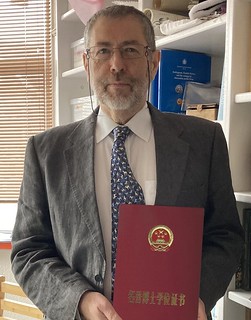 Professor Joe Cribb has been awarded the 2023 Derek Allen Prize for his outstanding contribution to the discipline of numismatics. In particular for his expertise and wide range in Asian numismatics, from the Far East via South and Southeast Asia to the Greek and later coinages of Bactria. His focus on the coinage of the Kushans and their successors, the Kushano-Sasanians and Kidarites, has led to a greatly improved understanding of the history of Afghanistan and adjacent regions in the early centuries CE.
Professor Joe Cribb has been awarded the 2023 Derek Allen Prize for his outstanding contribution to the discipline of numismatics. In particular for his expertise and wide range in Asian numismatics, from the Far East via South and Southeast Asia to the Greek and later coinages of Bactria. His focus on the coinage of the Kushans and their successors, the Kushano-Sasanians and Kidarites, has led to a greatly improved understanding of the history of Afghanistan and adjacent regions in the early centuries CE.
Joe Cribb is a specialist in the monetary history of Asia. He worked as a curator of Asian currencies at the British Museum for forty years before retiring 2010 as the Head of its Department of Coins and Medals. Throughout his career he has been committed to making the Museum's numismatic collections internationally accessible and to training young numismatists from around the world. Since his retirement he has become an adjunct professor of numismatics at Hebei Normal University, Shijiazhuang, and a trustee of the Ancient Indian and Iran Trust, Cambridge
He has authored and edited books on Chinese, Indonesian and Central and South Asian currencies and history, and introductory books on coins. He has also written many articles on Asian coins and numismatic practice. He has curated major exhibitions at the British Museum and Fitzwilliam Museum, Cambridge University. He is former President of the Royal Numismatic Society, London, and former Secretary General of the Oriental Numismatic Society.
His contributions to numismatics have been recognized by the medals of the Royal Numismatic Society, London, the American Numismatic Society, New York and the Indian Numismatic Society, Varanasi. He has also been honoured by Hebei Normal University, the Ashmolean Museum, the Institute of Silk Road Studies, Kamakura, and the Austrian Numismatic Society, Vienna.
Joe's current research is on the Kushan dynasty in Central and South Asia, the history of numismatic research in Japan and the relationship between money and art.
I am delighted to be the recipient of the Derek Allen Prize, established in memory of one of Britain's most important numismatic scholars. I feel honoured to be included in the list of eminent numismatic colleagues who have received this award. Numismatics is a collaborative discipline and I know that what I have achieved could not have been done without the support and friendship of many eminent scholars in this field. I can only name a few who deserve my particular thanks, my colleagues at the British Museum: Helen Wang, Elizabeth Errington, Vesta Curtis, Robert Bracey, Wannaporn Rienjang, Shailendra Bhandare, Andrew Burnett, and the late Nicholas Lowick and Martin Price, and to Dai Jianbing (Hebei Normal University), Nicholas Sims-Williams (Ancient India and Iran Trust), David Jongeward (Toronto), Gul Rahim Khan and Nasim Khan (University of Peshawar); I also have a debt of gratitude for the support of my late wife Margaret and our dear children and grandchildren and of my partner Linda Crook.
I am greatly encouraged by the receipt of this award to continue to push forward my research and to promote the importance of numismatics as a discipline, particularly for Asian history, and thank the Academy for this honour.
- Professor Joe Cribb, August 2023
To read the complete article, see:
Derek Allen Prize
(https://www.thebritishacademy.ac.uk/prizes-medals/derek-allen-prize/)
See also:
Joe Cribb is the 2023 Derek Allen Prize Winner
(https://new.coinsweekly.com/news/joe-cribb-is-the-2023-derek-allen-prize-winner/)
THE BOOK BAZARRE
VOCABULARY TERM: OFF CENTER
Here's another entry from Dick Johnson's Encyclopedia of Coin and Medal Terminology. I added some images from earlier E-Sylum articles. -Editor
Off Center. A striking error in which a blank does not fully enter into coining position and is struck only partially on its surface. In general off center coins are struck outside the collar, usually distorting the precise circle of the blank, with proper congruent obverse and reverse designs but leaving unstruck a crescent shaped area on the blank.
Off center coins are an anomaly of the feeding mechanism. It is the responsibility of this mechanism to pick up a single blank from the feeder tube and deliver this to a position above the collar, where the blank falls by gravity into coining position within the collar. When, for any reason, this does not happen the dies will create these partial strikes.
The collar normally forms the edge of the coined piece – either squared plain edge or reeded from the collar – since the blank is struck outside the collar all off center coins will have unshaped edges. The edges will appear either as they came from upsetting (that portion outside the collar), or as rounded flash from the blow outside the collar.
Often, off center struck pieces are not ejected. They may receive a second or subsequent blow. Also they may adhere to the die and form capping or cupping.
Off center strikes are totally random. They have occurred since striking has been mechanized, being an unfortunate but typical anomaly of presswork. These objects are rejects of coin production and are customarily discarded and melted. Very few early specimens have survived. Many kinds of modern off center coins exist. These include:
(1) Off center strike. The blank was not fed properly and did not fully reach coining position inside the collar. Instead it comes to rest partly on top of the collar, receives the blow of both dies on the part of the blank extending over into the collar.
The portion not coming between the dies, obviously does not receive an impression and remains blank.
The degree off center can range from a very small amount to only the slightest amount struck by the dies. Collectors express this by a percentage of degree, 95% off center would exhibit only the slightest amount of design showing.
The position of an off center strike is indicated by the position of a clock face. Off center coins which still retain the date of the piece – as in the 12 o'clock position –have more allure to error collectors. Some collectors form clock
exhibits of off center strike coins by the 12 clock positions and range from a few degrees off to 95% off.
(2) Double and multiple strike. Usually an anomaly of ejection, a coined piece struck a second time off center will be an off center multiple strike. Such an example would show parts of two impressions of die striking. Or a double strike can be a feeding error where the blank was only partially in position for a first blow, and yet struck again for a second blow – or rarely – for a third or subsequent blow.
(3) Saddle strike. These occur only when two or more dies (as quads with four dies) are locked side-by-side into position and the press forms as many coins with one blow as the number of dies in position. Two (or four) blanks are fed into coining position for each cycle of the press. When a blank is not fed into coining position between a pair of dies, but instead it comes between two dies – straddling across both and obviously not in either collar – each die will strike a portion of the planchet leaving the unstruck blank portion in the center. This center portion is usually buckled from the outward thrust of the blow, hence the term saddle (as if it were a tiny saddle).
There are several sub-varieties of saddle strikes, with and without previous struck pieces in one or both coining positions, for example. Others exist.
(4) Chain strike. Essentially a chain strike occurs when two blanks are fed into coining position at one time. The interface edge surfaces of the two pieces form in an unusual manner. They will flatten against each other and somewhat form a straight edge. These edges can be mated or matched with each other because of the design and their congruity. However, obtaining the two matching pieces is extremely rare. The two mated pieces form a dramatic exhibit.
The next two types are related:
(5) Partial brockage. This occurs when a struck piece is not ejected, but falls partially on the collar after the next blank is placed in coining position. The resulting strike mashes the coin on the collar into the blank. A partial brockage is the coin in position which bears an indistinct area formed by the non ejected coin.
(6) Stretch strikes. This is the coin that was lying on the collar. It gets stretched by the action of the die. It is off center and always has an unstruck portion on one side, and completely blank on the opposite side. There are stretch marks where the blank flowed over the edge of the collar. It was the piece on top of the partial brockage.
To read the complete entry on the Newman Numismatic Portal, see:
Off Center
(https://nnp.wustl.edu/library/dictionarydetail/516418)
WILLIAM HENRY RUE (1911-1972)
E-Sylum Feature Writer and American Numismatic Biographies author Pete Smith submitted this article on an Ohio coin collector's murder. A fascinating, sordid and sobering account. Thank you. -Editor
William Rue was an eccentric Ohio coin collector. His teenage grandson became interested in his collection. Warning: This story does not have a happy ending.
William Henry Rue was born in Darke County, Ohio, in 1911. He lived in Darke county and the city of Bradford all his life. His father was a German immigrant and farmer, John Rue, and mother was Iva Cassen Rue.
William married Dorthea Overla on December 30, 1933. They would have six daughters, two sons and a 1953 divorce.
Rue was a forklift driver for Hobart Manufacturing Co. He was also an agent for the Greenville Advocate and the Dayton Daily Sunday News. Rue was an active member of the Miami County Coin Club but not a member of the ANA.
Rue lived in an apartment but also owned a house where he kept a dog, his coin collection, antiques, old newspapers and hoards of other stuff. On March 13, 1972, he was found dead on the second floor of the house, lying face down on a bed, beaten and with a gunshot wound to the stomach. Ultimately seven people would be charged in the case with an eighth accomplice spared as a cooperating witness.
 Vaughn Rue was a grandson of William Rue and fourteen years old at the time. He testified that
he had stolen coins from his grandfather's house several times. In January he returned with
fifteen-year-old Thurman Wright to rob the house again. It took four teens to carry a foot locker
full of loot to a waiting car. This acquired treasure was shared around the school.
Vaughn Rue was a grandson of William Rue and fourteen years old at the time. He testified that
he had stolen coins from his grandfather's house several times. In January he returned with
fifteen-year-old Thurman Wright to rob the house again. It took four teens to carry a foot locker
full of loot to a waiting car. This acquired treasure was shared around the school.
The boys took the coins to the house of Thurman's father. James Wright. He helped the boys count their take. After spending some silver certificates at a service station in Medway, Ron Mossbarger (22) followed him outside and offered to help him dispose of the notes. He put Wright in contact with John Conley and Paul Chambers who offered to buy the stolen goods. Conley and Chambers were not satisfied with the deal. They wanted the whole collection. They offered the boys a 10% commission on whatever they could get and asked Vaughn to point out the location of the house to them.
Conley and Chambers hadn't planned on committing murder and that's when the plan went sideways. After the crime, Conley showed up at the Wright house with a bloody shirt which he discarded in the trash. James Wright provided him with another shirt.
Prosecutors charged John Conley with first degree murder and claimed that Rue interrupted a burglary by Conley and Cambers. Rue was shot, tied and beaten. They put him on a bed and bounced on him until his neck was broken.
Margaret Conley, wife of John, attended the first two days of the trial. Then on July 12, 1972, she was arrested and also charged with first degree murder.
The first trial of Conley ended in a mistrial on July 17. 1972, after three witnesses said that they had been threatened and feared for their lives if the trial was continued.
Conley was granted a new trial with Jury selection beginning in August. During a recess in the trial. Conley tore up pictures being drawn by a sketch artist.
On September 5, 1972, a jury found Conley guilty of second-degree murder and murder in the perpetration of a robbery. He fired his attorneys and petitioned for a new trial. He claimed that Paul Chambers acted alone in the commission of the crime. In December 1973, his request for a new trial was denied. He was sentenced to two concurrent terms of life in prison but released in 1990 after serving seventeen years and five months.
Paul Chambers was the accomplice in the murder. His defense team stated that he and Conley had worked together at Dayton Tire. Chambers suffered an industrial accident on December 19, 1967, that left him partially disabled and addicted to drugs. He cooperated with Conley because Conley supplied him with drugs.
Chambers testified that he and Conley shot up on heroin before the burglary. Afterwards, Conley gave two bags of money to his wife and told her to bury them.
On October 12, he pleaded guilty to a lesser charge of manslaughter. On October 24, 1972, he was sentenced to one to twenty years in prison. In November 1972, he signed an affidavit indicating that Conley was not involved in the murder. In December he testified that he wrote that statement because Conley threatened his life while they were both in the Ohio Penitentiary.
He was released from prison on February 13, 1973, and placed on five-year's probation. Paul Norman Chambers died on January 31, 1996.
Thomas Simpson was an accomplice who was never charged in exchange for his testimony against Conley and Chambers. He testified that Conley and Chambers spent the night with him after the murder. He and Conley went to Richmond to purchase heroin. At one point Conley got out of the car and threw the murder weapon in a creek.
In an unrelated incident on July 17 during the trial, Ronald Mossbarger was shot in the head by a
patron of the Suburban Club in Medway. Miami County prosecutor William Huffman stated,
Mossbarger, it is rumored, moves in the type of company where being shot is not uncommon.
In September he faced an unrelated charge of attempted breaking and entering following a June 28 incident at an ice cream parlor. In the 1980's he faced various charges for drug possession. He died in Las Vegas, Nevada, on November 3. 2009.
Did Vaughn Rue learn from his mistake and go on to lead a productive life? In 1977, at age 18, he was married to Kathy Cotrell, age 21. In 1978 he was charged with contributing to the delinquency of a minor. At about that time, his wife Kathy filed for divorce. He was served divorce papers while in the Lee County (FL) jail. In 1980, at age 21, he was engaged to Dawn Watkins, age 16. In 1984 at age 26, he was married to Cristie Baker, age 21. In 1988 at age 30, he was engaged to Veronica Embry, age 21. He held various unskilled jobs, had two sons, and died on June 5, 2017, at age 59.
While local newspapers had extensive coverage of the court cases for John Conley and Paul Chambers, they had little on legal action taken against Margaret Conley, Ron Mossbarger, Vaughn Rue, or James and Thurman Wright.
MORE ON THE FRANK S. ROBINSON SALE 122
The sale will include 596 lots of ancient and early world coins, low minimum bids, and bids to be reduced as competition permits. It includes a section of Judaic related coins, some very good British, early Chinese, a new section of Russian plus many group lots, and literature. -Editor
Lot 138 Vespasian, Den, IVDAEA, Jewess std r, beside trophy; EF, well centered, lgnds nrly complete albeit partly crude; excellent portrait of unusually fine style for this; rev exceptionally well detailed; ltly toned. Possibly a hint of smoothing, mentioned only in an excess of conscientiousness.
Lot 169 GERMANICUS, As, by Caligula, Bust l./SC in lgnd, Coh.1, Choice EF, perfectly centered with full strong lgnds, darkish greenish-brown patina, glossy surfaces, ltly smoothed; portrait quite sharply detailed. Slight surface disturbance at upper rev needn't be noted.
PHILIP I, Sest, FIDES EXERCITVS, 4 standards, EF/VF, centered, lgnds complete tho somewhat crude mainly on rev; hilighted green patina; outstanding portrait with every hair sharp.
VALERIAN II, Ant, PRINC IVVENTVTIS, Val crowning trophy; Choice EF, virtually as struck, centered on a large sl ragged flan, quite well struck with lgnds actually bold, sharp portrait detail. Lustery silver. It takes a lot of work for me to produce coins of this quality
For more information, or to bid, see:
http://www.fsrcoin.com/f.html
https://www.biddr.com/auctions/fsrcoin/browse?a=3815
You can also bid by email by writing to Frank at frank@fsrcoin.com .
To read the earlier E-Sylum article, see:
FRANK S. ROBINSON 122ND AUCTION
(https://www.coinbooks.org/v26/esylum_v26n39a21.html)
MDC OCTOBER 2023 FRENCH COLLECTION SELECTIONS
Here are some more selections from The French Collection offered in this month's MDC Monaco Auction No. 12. -Editor
presented by MDC Monnaises de Collection
Auction October 11, 2023
MDC Monnaies de collection is excited to auction The French Collection
in October 2023.
The collection of 540 lots, built over 40 years, includes the most beautiful coins from the
French Revolution to the Fifth Republic, with a vast majority of Top Pop. Today, it is not
possible to recreate such a collection. We know that many collectors will find in it the special
coins they have been looking for. The auction will take place in Monaco at the Hôtel Métropole on the 11th of October 2023, from 1:30 pm to 4 pm (lots 1 to 296) and from 4:15
pm to 7 pm (lots 297 to 540), Nicolas Gimbert, Auctioneer.
To view the complete collection:
https://mdc.mc/auction/vente-aux-encheres-numismatique-12/
Lot 15: FRANCE / CAPETIANS Constitution (1791-1792). Half shield of 3 FRENCH books 1792, 2nd semester - Year 4, An 4, BB, Strasbourg. Av. LOUIS XVI KING OF THE FRENCH. Head to the left of the King, hair tied with a ribbon at the nape of the neck. Below (different) (date). Rev. REIGN OF LAW. The Genius of France engraving the word CONSTITUTION (in two lines) on a table of the law resting on an altar, accosted with (different) and a beam on the left, with a rooster and (workshop) on the right. Signature DUPRÉ hollow on the base of the altar. In the epigraph: THE YEAR (date) OF FREEDOM in two lines. G.42-Dy.1719; Silver - 14.74 g - 32 mm - 6 h. Top Pop: it's the most beautiful graded coin!
PCGS MS64. Very rare type which hardly ever goes on sale and only 2 copies graded at PCGS, the other in VF30! Minimal adjustment lines. This copy has barely circulated, with a patina with golden reflections. Superb at Fleur de Coin.
Starting price: 3000€
Lot 22: FRANCE Agreement (1792-1795). E Essay or prototype of the floor on the FRENCH scale, signature in relief and exergue line 1793 - Year II, A, Paris. Av. FRENCH REPUBLIC / L'AN (date). Table inscribed MEN ARE EQUAL BEFORE THE LAW and embossed Dupré signature, under a beaming eye, between a bunch of grapes and ears of wheat, with an exergue bar. Rev. LIBERTY EGALITY. Flail of a balance surmounted by a liberty cap, on which is a crown with in the center: 1 S.; below (workshop) and (different) (date) (different). G.20v. - Maz.292 c. - VG.415; Copper - 11.67 g - 28.5 mm - 6 h. Top Pop: it's the only graded coin!
NGC MS 64 BN. Signature Dupré cursive and in relief, with highlight bar on the right under the Table. In mint condition, with a slight brown patina forming. Corner flower.
Starting price: 1500 €
Lot 36: FRANCE Directory (1795-1799). A decime Dupré, overstrike of 2 decimes AN 5 (1796), T, Nantes. Av. FRENCH REPUBLIC. Bust of the Republic to the left, wearing a liberty cap; below cursive signature Dupré. Rev. In a wreath formed of two oak branches: A DECIME. The year (date). (different) (workshop) (different). G.185 - F.128; Copper - 20 g - 32 mm - 6 h. Top Pop: it's the most beautiful graded coin!
PCGS MS64BN. Quality overstrike, very well received and barely showing 2 DECIMES. In mint condition, with a brown patina. Almost corner flower. G.185 - F.128; Copper - 20 g - 32 mm - 6 h.
Starting price: 1000 €
Lot 39: FRANCE Directory (1795-1799). 5 francs Union et Force, listel per ferrule Year 4 (1795), A, Paris. Av. UNION AND FORCE. Hercules standing facing with Leont, uniting Liberty standing left holding pike surmounted by liberty cap, and Equality standing right, holding level. Around, the different. In the epigraph cursive signature Dupré. Rev. FRENCH REPUBLIC *. In a wreath formed of an oak branch and an olive branch: 5 FRANCS. The year (date). ; below (workshop). G.563-F.287; Silver - 25 g - 37 mm - 6 h. Top Pop: it's the most beautiful graded coin!
PCGS MS63. Strikes with ferrule, with clear listels! Flower of the particular slice. Of exceptional quality for this type, with all its original freshness. Almost Fleur de Coin.
Starting price: 3000 €
Lot 43: FRANCE Consulate (1799-1804). 1 franc Bonaparte, Presentation mint (SP) Year XI (1802-1803), A, Paris. Avenue BONAPARTE FIRST CONSUL. Bare head to the right, Tiolier signature below. Rev. FRENCH REPUBLIC. In a crown formed of two branches: 1 FRANC. Below (different) AN (date) (mint). G.442-F.200; Silver - 5 g - 23 mm - 6 h. Top Pop: it's the only graded coin!
PCGS SP63. Special strike (SP) and certainly a presentation test of the newly created Franc Germinal! The listels are wide and marked: a major piece for the history of modern French numismatics. Minimal marks on the right. Nice collector's patina. Superb at Fleur de Coin.
Starting price: 3000 €
Lot 51: FRANCE First Empire / Napoleon I (1804-1814). Demi-franc revolutionary calendar Year 12 (1803-1804), A, Paris. Av. NAPOLEON EMPEREUR. Bare head to the right, cursive Tiolier signature below. Rev. FRENCH REPUBLIC. Within a crown formed of two branches: HALF FRANC, below (different) AN (date) and (mint). G.395-F.174; Silver - 2.5 g - 18 mm - 6 h. Top Pop: it's the most beautiful graded coin at PCGS! (one coin in 65 at NGC)!
PCGS MS64. In its mint condition. Very nice collector's patina. Almost Fleur de Coin.
Starting price: 300 €
Lot 58: FRANCE First Empire / Napoleon I (1804-1814). 40 francs naked head, revolutionary calendar Year 13 (1805), A, Paris. Av. NAPOLEON EMPEREUR. Bare head left, DROZ F. on the edge of the neck and below Tr Rv signature. FRENCH REPUBLIC. In a crown formed of two olive branches: 40 FRANCS and below. (different). YEAR (date) .(workshop). G.1081 - F.537 - Fr.481; Gold - 12.9 g - 26 mm - 6 h. Top Pop: it's the most beautiful graded coin!
PCGS MS64. Near original condition, with only micro-marks on the punch pile and in the fields. Slightly cameo in appearance on the right. Remarkable quality for this type. Superb at Fleur de Coin.
Starting price: 3000 €
Lot 70: FRANCE First Empire / Napoleon I (1804-1814). 2 francs, African type 1807, A, Paris. Av. NAPOLEON EMPEREUR. Bare head to the right, Tiolier signature below. Rev. FRENCH REPUBLIC. In a crown formed of two branches: 2 FRANCS; below (different) (date). (workshop). G.499-F.253; Silver - 10 g - 27 mm - 6 h. Top Pop: it's the most beautiful graded coin!
NGC MS62. Some micro-scratches on the right and tiny handling marks. With a gray patina on the original gloss. Superb at Fleur de Coin.
Starting price: 4000 €
Lot 71: FRANCE First Empire / Napoleon I (1804-1814). 5 francs transitional type 1807, A, Paris. Av. NAPOLEON EMPEREUR. Bare head on the right, signature BRENET and cursive Tr below. Rev. FRENCH REPUBLIC. In a crown formed of two branches: 5 FRANCS; below (different) (date). (workshop). G.582 - F.305 - Dav.83 - Maz.441b; Silver - 25 g - 37 mm - 6 h. Top Pop: it's the most beautiful graded coin at PCGS! (one coin in 65 at NGC)!
PCGS MS63+. Exceptional copy with tiny marks and some flat spots on the high points of the relief. Centered and perfect shot. Magnificent collector's patina with iridescent reflections. Very rare type. Almost Fleur de Coin.
Starting price: 15000 €
Lot 107: FRANCE Louis XVIII (1814-1824). 5 francs dressed bust, Flan bruni (PROOF) 1814, A, Paris. Av. LOUIS XVIII KING OF FRANCE. Dressed bust of Louis XVIII on the left, below signature TIOLIER F. Rv. COIN OF 5 FRANCS. Crowned shield of France, between two laurel branches, below (different) (date) (mint). G.591-F.308; Silver - 25 g - 37 mm - 6 h. It's the second highest grade!
PCGS PR64. Burnished flan (PROOF) with a sumptuous gray patina with bluish reflections. A few known copies in burnished blanks. Superb at Fleur de Coin.
Starting price: 3000 €
To read the earlier E-Sylum articles, see:
MDC OCTOBER 2023 FRENCH COLLECTION
(https://www.coinbooks.org/v26/esylum_v26n32a27.html)
MDC OCTOBER 2023 FRENCH COLLECTION 5 FRANCS
(https://www.coinbooks.org/v26/esylum_v26n36a23.html)
MDC OCTOBER 2023 FRENCH COLLECTION GOLD
(https://www.coinbooks.org/v26/esylum_v26n37a26.html)
MDC OCTOBER 2023 FRENCH COLLECTION 1791-1795
(https://www.coinbooks.org/v26/esylum_v26n38a29.html)
MDC OCTOBER 2023 FRENCH COLLECTION NAPOLEONIC
(https://www.coinbooks.org/v26/esylum_v26n39a22.html)
NUMISMATIC NUGGETS: OCTOBER 1, 2023
Here's a selection of interesting or unusual items I came across in the marketplace this week. Tell us what you think of some of these. -Editor
1587 Protestants Supported Medal
Protestants Supported in the United Provinces, AR Medal, 1587, by Gerhard van Bijlaer, DEO OPT MAX LAVS ET HONOR IN OE ÆVVM QVOD (m.m rose), saltire stops, Elizabeth enthroned, attended by her courtier, the Earl of Leicester, as she tramples on a hydra, five naked figures kneel before a shield representing the provinces, 1587 in exergue, rev. QVEM DEVS CONFICIET SPIRITV ORIS SVI, saltire stops, popes, bishops and other religious figures fall from celestial clouds, 53mm, 45.11g, 12h (MI i 139/99; van Loon I, 369; Eimer 53), struck on a slightly concave flan, once lightly cleaned and now retoned, very fine, scarce
From the Spink COINEX Auction. -Editor
To read the complete lot description, see:
PROTESTANTS SUPPORTED IN THE UNITED PROVINCES, AR MEDAL, 1587, BY GERHARD VAN BIJLAER, DEO OPT...
(https://live.spink.com/lots/view/4-B5RKYN/protestants-supported-in-the-united-provinces-ar-medal-1587-by-gerhard-van-bijlaer-deo-opt)
1796 Ventriloquist Token
London - uncertain locality, Joseph Askins (ventriloquist), Jacob's Halfpenny 1796, Man standing left with peg-leg, rev. four-line legend, edge diagonally milled, 29mm/9.43gm. (DH 252a). Good Extremely Fine with some iridescence and fair amount of original lustre, rare ‘R'. Ex. ‘an old Surrey Col.' via Mark Rasmussen Sep. 2016
Cool piece from Baldwin's sale of the Deane Collection Part III (Auction 112, October 11, 2023). -Editor
To read the complete lot description, see:
London - uncertain locality, Joseph Askins (ventriloquist), Jacob's Halfpenny 1796
(https://thestrand.com/auctions/calendar/list#/lots/0dd643c7-1e44-4424-b079-2fd90651d1d0)
1838 New York and Harlaem Railroad Token
Hard Times token LOW 370 R5 HT-298 EF Details with scratches. The N-York & Harlaem Railroad Company. B & S N.Y. with railroad car on reverse (600-750)
Historic transportation token from the eBay offerings of Steve Hayden. Interesting and desirable despite the scratches. -Editor
To read the complete lot description, see:
1838 New York City Hard Times Token Harlaem Railroad Harlem HT-298 Low 370
(https://www.ebay.com/itm/225785098009)
Civil War Scrip Payable in Confederate Notes
Franklin Foote and Millet 10c
Grade: F/VF
July 22, 1862. White and Son Printers.
A great Civil War note payable in Confederate Notes. From the October 11, 2023 Lyn Knight auction. -Editor
To read the complete lot description, see:
Franklin Foote and Millet 10c
(http://www.lynknight.com/items/1195985)
Scheinfeld Camp Money
United Nations, 1946. Lot of 3 Issued Scrip Notes from the Scheinfeld DP camp located in Bavaria, Includes: 10 Centu on light green-blue paper, S/N 002554; 50 Centu on dark green paper, S/N 01323; 1 Doleris on tan paper, S/N 01147. Scheinfeld camp money is bilingual – Lithuanian on the obverse, English on the reverse. All notes feature a red serial number on the obverse, while a blue, hand-stamped Scheinfeld UNRRA (Team 569)
emblem resembling a globe appears on the reverse. Notes are in AU-UNC condition. (3). Sold "AS IS" no returns accepted.
From the October 24, 2023 Archives International sale. -Editor
To read the complete lot description, see:
UNRRA Team 569, 1946, Lot of 3 Displaced Persons Camp Scrip Notes
(https://auction.archivesinternational.com/UNRRA-Team-569-1946-Lot-of-3-Displaced-Persons-Camp-Scrip-Notes_i50392087)
COINS OF THE FALL OF ROME
Mike Markowitz published an articles in his CoinWeek Ancient Coin Series on "Shadow Emperors: Coins of the Fall of Rome." Here's an excerpt - see the complete article online. -Editor
THE ROMAN EMPIRE in the West died not with a bang, but with a whimper. A series of short-lived rulers, mostly puppets of barbarian warlords, presided over the accelerating collapse of a state that had endured for five glorious centuries. The coins issued in the names of these so-called Shadow Emperors
help to illustrate this dramatic and melancholy story.
Gold Solidus of Petronius Maximus (455 CE). Image: Classical Numismatic Group.
Things took a sharp turn on March 16, 455 CE, when Emperor Valentinian III was murdered by two hit men when he dismounted his horse on the Campus Martius, a large open field in Rome. The assassins were avenging the death of Flavius Aetius, Rome's last great military commander, killed in a fit of rage by Valentinian the year before. The assassination was arranged by Petronius Maximus, a powerful senator, who proclaimed himself emperor the next day, forcing Valentinian's widow, the beautiful Licinia Eudoxia, to marry him.
Despite his brief tenure, Petronius managed to issue gold solidi at Rome and some very rare examples from Ravenna.
Gold Solidus of Avitus (455-456 CE). Image: Goldberg Auctioneers.
Marcus Maecilius Eparchius Avitus came from a distinguished Senatorial family in what is now the Auvergne region of central France. His date of birth is unknown. A talented diplomat and military leader, he was promoted to the high rank of magister militum (master of soldiers
) by Petronius Maximus. While visiting the court of the Visigothic king Theodoric II, Avitus learned of the death of Petronius. With Visigothic support, he was proclaimed emperor on July 9, 455.
Thanks, Mike. Sad but fascinating history. The Emperor Valentinian story reminds me of the old joke: "What goes clop clop BANG, clop clop BANG? .... an Amish drive-by shooting. -Editor
To read the complete article, see:
Shadow Emperors: Coins of the Fall of Rome
(https://coinweek.com/shadow-emperors-coins-of-the-fall-of-rome/)
JERSEY COIN HOARD RESEARCH MONEY ALLOCATED
Money has been allocated for further research on the massive coin hoard found on Jersey in 2021. -Editor
Chairman of the Highlands Foundation, David Lord and His Majesty's Receiver General for Jersey, Alan Blair at the display of the hoard at Le Hougue Bie
Ringfenced money from the largest iron age coin hoard in Jersey's history has been allocated to a foundation for science and research.
The Le Catillon II hoard was uncovered by two local amateur metal detectorists in 2012.
The Government of Jersey bought the hoard for £4.25m in 2021 after negotiations with the Crown, which claimed the discovery as a treasure trove in accordance with Jersey customary law.
Part of the financial settlement included £250,000 for scientific and educational research of the hoard, which the government has given to the charitable arm of Highlands College.
Chair of the Highlands College Foundation, David Lord, said: "The opportunity for Highlands College and the foundation to be involved in further discovery work of the Le Catillon Hoard is very exciting."
The money will be made available before the end of the year to staff, students, and alumni of the college, as well as for research by any third party in Jersey or from overseas wishing to further investigate the historic discovery.
To read the complete article, see:
Coin hoard research money allocated to foundation
(https://www.bbc.com/news/articles/cz5egjrdplxo)
To read earlier E-Sylum articles, see:
JERSEY GROUVILLE HOARD BEING DISMANTLED
(https://www.coinbooks.org/esylum_v17n35a32.html)
https://www.coinbooks.org/v22/esylum_v22n12a24.html
(https://www.coinbooks.org/v22/esylum_v22n12a24.html)
CORRECTIONS: GROUVILLE HOARD DETAILS
(https://www.coinbooks.org/v23/esylum_v23n07a13.html)
LONDON BRIDGE HERO RECIEVES QUEEN'S MEDAL
The Polish worker who fought the London Bridge terrorist in 2019 has been awarded the Queen's Medal for Gallantry. Amazing story. -Editor
A Polish hero who used a ceremonial pike to fight off a terrorist on London Bridge in 2019 has been awarded the Queen's medal for bravery.
In a ceremony at Windsor Castle, Princess Anne presented Lukasz Koczocik with the Queen's Medal for Gallantry, which recognises exemplary acts of courage.
In 2019, then-kitchen porter Koczocik had been washing glasses in the basement of Fishmongers' Hall in London when he heard blood-curdling screams from upstairs.
Finding that terrorist Usman Khan had killed two people during a prisoner rehabilitation event being hosted at the Grade II listed building, Koczocik grabbed the ornament known as a boarding pike and attempted to disarm Khan.
The Polish hero suffered brutal slash wounds as the two became locked in kill-or-be-killed combat, allowing panicking guests to escape.
Koczocik was then joined by two others and, despite his wounds, chased Khan outside on to London Bridge where the terrorist was then shot dead by armed police.
Upon receiving his award on Tuesday, Koczocik told the PA news agency: This medal closed the matter, I have already put this attack behind me, and yet it is an incredible honor.
I just did what I thought was right at that time and place, I never considered myself a hero.
Fishmongers' Hall where Koczocik still works after being promoted to head porter posted on its website: It is with the greatest pride that the Company relays that staff member Lukasz Koczocik has been awarded the Queen's Gallantry Medal for his actions in tackling the terrorist during the tragic incident at Fishmongers' Hall on 29th November 2019.
To read the complete article, see:
Hero Polish porter who fought off London Bridge terrorist collects bravery award from Princess Anne
(https://www.thefirstnews.com/article/hero-polish-porter-who-fought-off-london-bridge-terrorist-collects-bravery-award-from-princess-anne-41660)
See also:
Fishmongers' Hall porter 'stabbed Usman Khan with spear'
(https://www.bbc.com/news/uk-england-london-56815632)
NOONAN'S OFFERS RARE BANK OF ENGLAND NOTES
Here's the press releases for the Thursday, October 12, 2023 Noonan's sale of some rare Bank of England notes. -Editor
An exceptionally rare Bank of England £5 note that was issued in Leeds is expected to fetch £12,000-£16,000 when offered in a sale of British and Irish Banknotes at Noonans on Thursday, October 12, 2023. Dated July 12, 1900, it is signed by Horace G. Bowen who was Chief Cashier at the Bank of England from 1893 to 1902.
As Andrew Pattison, Head of Banknote Department at Noonans commented: This is a great
note. Very few Bowen notes are in private hands especially from this exceptionally rare Leeds
branch. The York hand stamp shows part of the journey of the note, issued in Leeds and paid
into a bank at some point in York.
He continued: This note was sold by Sir David Kirch as part of his collection a decade ago
when it was sold to the current owner, who is a major collector of notes from all over the
United Kingdom.
This is not the first Leeds note that Noonans has sold. An extremely rare £500 note dated
1936 was sold for a hammer price of £24,000 in March of this year.
The sale will include several rare Bank of England notes. Also from Leeds is a very rare £5 note signed by Matthew Marshall who was Chief Cashier of the Bank of England between 1835 and 1864 and is dated 28 July 1862. It is expected to fetch £10,000-£15,000.
Others include an excessively rare £50 note also signed by Matthew Marshall dated 6 October 1845. This high denomination note is estimated at £15,000-20,000. A very early £2 note signed by Abraham Newland, who was Chief Cashier of the Bank of England between 1782 and 1807 and dated 20 November 1798, carries an estimate of £12,000-16,000.
For more information, see:
https://www.noonans.co.uk/
ARAMCO COUPONS
Thanks to their listing in the Red Book and Roger Burdette's new book, we're all aware of the Saudi gold discs. But I was unaware of the Arabian American Oil Company (Aramco) coupons, which circulated as currency for a time. Here's a short article mentioning them. Have these been published or catalogued elsewhere? -Editor
Saudi Arabia's founder King Abdulaziz bin Abdulrahman ordered in 1950 the minting of the Saudi guinea, kickstarting the development of the Kingdom's national currency.
The minting of the guinea was linked to the formation of the Aramco oil company and the aftermath of World War II.
Aramco employees were initially paid their wages in the form of ten pounds of silver, or 4.5 kgs. In 1932, the company issued paper currency known at the time as Aramco coupons.
In the 1940s, and due to WWII, the world witnessed a shortage in the English pound, forcing Aramco between 1946 and 1947 to mint currencies in Philadelphia in the United States to pay Saudi Arabia the cost of the oil. The currencies, known as Aramco dollars, matched the pound in quality.
Al-Harbi told Asharq Al-Awsat that the Aramco dollars ranged from one to four dollar notes. Years later, King Abdulaziz would develop the currency into the Saudi guinea.
The Aramco coupons would eventually transform into the Kingdom's currency. Pilgrims' Receipts were printed in 1952 to facilitate the procedures of Hajj pilgrims. They eventually spread throughout the Kingdom and were used as local currency as well.
Found via News & Notes from the Society of Paper Money Collectors (Volume IX, Number 15, September 26, 2023). -Editor
To read the complete article, see:
The Saudi National Currency's Evolution from King Abdulaziz Guinea to Aramco Coupon
(https://english.aawsat.com/gulf/4563101-saudi-national-currency%E2%80%99s-evolution-king-abdulaziz-guinea-aramco-coupon)
To read the earlier E-Sylum article, see:
NEW BOOK: SAUDI GOLD
(https://www.coinbooks.org/v26/esylum_v26n10a02.html)
PENNY PEEVE
This week's potential shutdown of the U.S. government gave opinion writers another opportunity to air their pet peeves, and since Dick Johnson isn't here to point this one out, I'll do it for him. An article in the Chicago Sun Times laments the continued production of the U.S. cent. -Editor
It costs 2 cents for the United States Mint to manufacture a Lincoln cent. In 2021, the government struck 7.1 billion of them. Two-thirds never circulate. They clutter up banks. Yet we keep minting them.
Whenever the nation's greatness
is bandied about, by those who imagine greatness is a quality that can be self-assigned, a little voice says, Yeah, we can't even get rid of the penny.
Australia managed. In 1990. Canada, too — a decade ago. Also Brazil, Finland, New Zealand, Norway, Israel — quite a list. Are they greater
than we are? Certainly pennywise.
When Barack Obama came into office, he said he was interested in learning what pressure groups keep us from eliminating the penny. No big secret. There's congressional pressure from a company that makes zinc blanks — despite appearances, a cent is 98% zinc.
Plus CoinStar, which makes the machines that count coins in supermarkets. You'd think that the zinc blank and coin counting machine industries would not have the lobbying might to dictate national policy in a vibrant democracy. But you'd be wrong. The shock isn't how corrupt our leaders are, but how little they sell us out for.
Obama was able to pass a system of national health insurance. Getting rid of the penny was beyond his abilities.
The article continues with a decent numismatic lesson, something the popular press usually messes up. -Editor
We in Illinois are supposed to be especially attached to the Lincoln penny, being the land of Lincoln. But we are also supposed to be even more attached to the idea of liberty and not being in the thrall of despots. When the Lincoln penny was introduced, to mark the centennial of his birth in 1909, a tradition of 122 years was broken.
Ever since the first U.S. coin had been struck in 1787 — a penny, of course — no president was depicted on a coin, because that reeked of kings aggrandizing themselves, and we were supposed to be a free people.
Thus, coins carried images of Liberty, in the form of a lady — a reminder that veneration is not respect. A nation of men carrying coins honoring women nevertheless denied them the right to vote. Women could embody freedom, they just couldn't enjoy it.
Take a closer look at that first penny. It's called the Fugio cent
because one side displays a sundial and the Latin word fugio,
or I fly,
which is what time does. The next 45 days will certainly speed by until we go through this all again.
Flip the coin over, and there are 13 rings, interlocked together, for the 13 joined colonies. United States
it reads, WE ARE ONE.
Yes, that was never true. The abolitionists of Massachusetts were never one with the slave drivers of South Carolina.
But it's really, really not true now. A time when most of us go weeks and never touch currency, never mind coins. I'm afraid that decades from now, when you walk in a store, grab products and unseen cameras scan your retinas and deduct your account, mountains of pennies will still be struck, transferred to banks to sit until they're returned, melted down and struck again.
To read the complete article, see:
A penny for your thoughts
(https://chicago.suntimes.com/columnists/2023/10/1/23898096/penny-government-shutdown-steinberg-column)
COLLECTING NAZI MEMORABILIA
In the collectors-gonna-collect department, a Friday New York Times opinion piece asks, "What Kind of Person Has a Closet Full of Nazi Memorabilia?" We all know one kind - the collector. Here's a spotty excerpt, which can't do justice to the complete article available online. -Editor
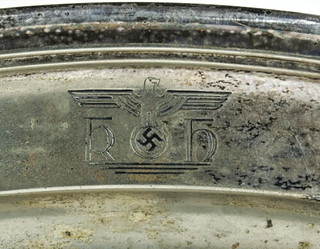 At the Ohio Valley Military Society's annual Show of Shows, there is plenty for sale that isn't Nazi memorabilia. All sorts of mementos from all sorts of wars: Civil War caps, antique pistols, Purple Hearts, samurai swords, World War I trench kits. But there is a lot of Nazi memorabilia.
At the Ohio Valley Military Society's annual Show of Shows, there is plenty for sale that isn't Nazi memorabilia. All sorts of mementos from all sorts of wars: Civil War caps, antique pistols, Purple Hearts, samurai swords, World War I trench kits. But there is a lot of Nazi memorabilia.
For a while I shadowed a tall, affable dealer from Belgium who specialized in badges and who'd already spent nearly all of the $100,000 in cash he'd brought with him. He stopped at one table and efficiently inspected a couple of dozen Nazi-era Iron Crosses, whispering to me which were fake or had been modified, before settling on one he liked, or at least thought worth the $500 he paid for it.
I'd gone to the Show of Shows, the largest military memorabilia show in the country, because I wanted to better understand the trade in Nazi artifacts, to try to get a sense of these collectors, their motivations.
For years I've seen up close the pull Nazi artifacts can exert. I've spent time with Polish treasure hunters seeking, and occasionally finding, any variety of objects left behind by the Nazis. But I hadn't understood how pervasive the trade was — hadn't understood, in fact, that it was a trade, how thoroughly these artifacts had been commodified. And I certainly hadn't realized how the big the market was here, in the United States.
What opened my eyes was learning how much Nazi stuff there was on LiveAuctioneers, the pre-eminent online platform for antiques dealers. According to a Times Opinion analysis, the site has published more than 30,000 listings for Nazi memorabilia in the past 15 years, making it probably the biggest, and certainly the most mainstream, purveyor of Nazi artifacts in the country. Although LiveAuctioneers' policy prohibits items that glorify or otherwise capitalize on human tragedy with no regard or sensitivity to the suffering caused by such events,
genuine Nazi artifacts are generally exempt, as they're considered historical.
(Most other major platforms have enacted more stringent policies. EBay, for example, bars any item that bears a swastika, with some exceptions for currency, stamps, historically accurate models and dioramas and photos, books and art, as well as items that predate 1933.)
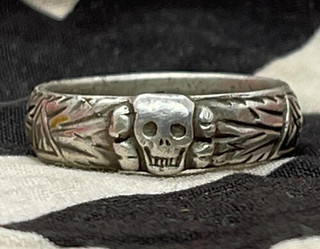 News that someone is into Nazi memorabilia or more generally that there's a ready supply of and demand for Nazi memorabilia is met, predictably, with widespread outrage (if perhaps also with some measure of titillation). If no one seems all that shocked that it's legal — the sanctity of the First Amendment is baked deep into the American psyche — then I think it's fair to say that people are upset, or at least weirded out, that such items are bought and sold, promoted, profited from, and treasured. People cannot imagine how any non-Nazi could be into this stuff, with the corollary that anyone who is into this stuff must be a Nazi or basically a Nazi or is sufficiently Nazi-philic to warrant extreme suspicion.
News that someone is into Nazi memorabilia or more generally that there's a ready supply of and demand for Nazi memorabilia is met, predictably, with widespread outrage (if perhaps also with some measure of titillation). If no one seems all that shocked that it's legal — the sanctity of the First Amendment is baked deep into the American psyche — then I think it's fair to say that people are upset, or at least weirded out, that such items are bought and sold, promoted, profited from, and treasured. People cannot imagine how any non-Nazi could be into this stuff, with the corollary that anyone who is into this stuff must be a Nazi or basically a Nazi or is sufficiently Nazi-philic to warrant extreme suspicion.
This is a valid and justifiable response — it's an excellent rule of thumb, to be on the side that's against Nazis — but at the same time it strikes me as incomplete. It does not reckon with who the collectors are or why they collect nor does it address the principles the market is built on, or what it in fact espouses.
The truth is that many collectors of Nazi memorabilia are, in fact, collectors, a term I'm using semi-technically to describe those who dedicate themselves, often obsessively and for reasons inscrutable to the outsider, to amassing some or other class of objects, usually something interestingly varied in terms of condition, provenance and rareness — action figures, stamps, coins, Pez dispensers. This isn't to say there's never a profit motive, but there is, or at least at some point was, a base desire on the part of collectors to, simply, possess.
There's a lot to collect,
Michael Hughes, the author of The Anarchy of Nazi Memorabilia: From Things of Tyranny to Troubled Treasure,
told me. Absolutely, Nazi memorabilia appeals to the systematic collector who collects complete series, like baseball cards.
Dr. Hughes, an academic who describes himself as a reformed collector
and who has interviewed or otherwise interacted with hundreds of collectors of Nazi memorabilia, says most aren't all that strange or exceptional, at least with respect to the larger collecting community. Generally the people I have met over the last 30 years are just your average Joes,
he said.
There are collectors of Nazi memorabilia who are Jewish, whose relatives died in the Holocaust. None were eager to speak with me on the record — not because they thought they were doing anything shameful but because, as one told me, Most people don't get it, and will never get it
— but made it clear that their fascination with Nazi artifacts in no way diluted their completely standard views regarding World War II, Nazis and the Holocaust.
One collector I spoke to explained it in terms of Star Wars
: Which is more compelling, he asked, the Light Side or the Dark Side?
To read the complete article, see:
What Kind of Person Has a Closet Full of Nazi Memorabilia?
(https://www.nytimes.com/2023/09/29/opinion/nazi-memorabilia-market-liveauctioneers.html)
THE LEGEND OF NEW YORK'S HELL GATE TREASURE
Larry Edwards passed along this Atlas Obscura article about New York's legendary Hell Gate Treasure - the 1780 wreck of the HMS Hussar, rumored to be carrying the payroll of British troops in gold coins. Thanks! -Editor
Just off the coast of Astoria, Queens, at the confluence of the Harlem and East Rivers, is a narrow tidal channel. Hell Gate. Its fast currents change multiple times a day and it used to be riddled with rocks just beneath the surface.
Hell Gate is the final resting place of literally hundreds of ships. Most of them are forgotten but one continues to captivate. Because down there, under the minor maelstroms, is the promise of gold.
You're talking about centuries of navigation,
says Bronx Borough Historian Lloyd Ultan. Everything from rowboats to large ships have been sunk by hitting those rocks. One on top of the other on top of the other on top of the other.
Out of all those wrecks, one in particular has obsessed people for over 240 years—HMS Hussar. The whole gamut of underwater exploration technology has been employed in the search for its purported treasure, from 18th-century diving bells to modern sonar scanners. The cast of characters who have invested significant time and money into salvaging the ship is equally wide-ranging. Thomas Jefferson had a go, as did the inventor of the modern submarine. Alongside crews of schemers and hustlers, serious underwater archaeologists have tried, too. Most recently the most prominent attempts to find the wreck were the brainchild of a Bronx man who calls himself Joey Treasures.
The coveted ship was a frigate of the Royal Navy that arrived in British-occupied New York during the Revolutionary War, in November 1780, reportedly carrying the payroll of British troops in gold coins. Shortly after arriving in the city, Hussar set sail for Gardiner's Bay on the eastern end of Long Island (though some accounts say it was headed to Newport, Rhode Island). While traversing Hell Gate it hit a submerged formation known as Pot Rock and began taking on water. The ship drifted down the East River until it sank to a depth of 60 to 80 feet, somewhere off the coast of the Bronx. This much is known. The rest, much like the waters of Hell Gate, is murky.
Accounts differ on how many, if any, of the crew were lost, but most agree that around 60 American prisoners of war who were shackled below deck went down with the ship. Crucially, whether Hussar still had gold on board when it sank has also been the subject of much debate over the past two centuries. Modern historians tend to think not. Contemporaneous news articles about the accident made no mention of treasure, nor do the minutes from the Royal Navy court martial into the loss of the frigate.
It's a pie-in-the-sky romantic notion that you could find gold in the waters of the Bronx,
says Ultan. But this did not stop generations of people from trying, beginning in the early 19th century. It was known that the ship was carrying gold when it arrived in New York, and in the decades after Hussar sank, the legend began to grow that the gold was still on the ship,
says Ultan. The East River at the southeastern end of the Bronx suddenly becomes the Spanish Main.
By the 1810s, the notion that a fortune in gold was lying near the bottom of Hell Gate had become an almost-uncontested truth in the New York press, and would remain so well into the 20th century. You have to remember it's a good story,
says Ultan. It sells copy.
Press speculation on the value of the gold varied wildly. The large amount
vaguely referred to in early articles suddenly became the oddly specific sum of £600,000, and then $1,000,000, then $5,000,000. In the 1980s, an international coin dealer told The New York Times that the bullion said to be in the Hussar wreck could fetch a whopping half a billion dollars in the rare coins market. Everything gets distorted,
says Ultan. It's like a game of telephone.
In 1811, a salvage company partially funded by Thomas Jefferson managed to bring up iron nails and copper, which amounted to a considerable sum,
according to an article in the ew York Evening Post from that year. They also raised a barrel of butter, value unknown, but alas, no gold.
McGowan's Pass, now in Central Park, was a British position during the Revolutionary War. Today, a cannon from HMS Hussar marks the site. In 2013, the Central Park Conservancy discovered that it was still loaded, and called on the NYPD bomb squad to defuse it.
To read the complete article, see:
Is There Sunken Treasure Beneath the Treacherous Currents of Hell Gate?
(https://www.atlasobscura.com/articles/sunken-treasure-hell-gate-new-york-east-river)
LOOSE CHANGE: OCTOBER 1, 2023
Here are some additional items in the media this week that may be of interest. -Editor
The mainstream press can get an awful lot wrong about numismatics, but one area where they shine is profiling coin designers and subjects, bringing new perspectives not always found in the numismatic world. This item from the Christian Post discusses the subject of the Jovita Idar quarter as a Methodist social reformer. -Editor
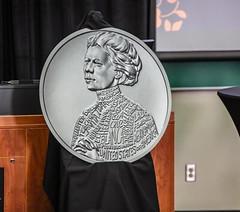 The U.S. Mint has released a quarter celebrating the life and accomplishments of Jovita Idar, a Mexican-American journalist and Methodist social reformer.
The U.S. Mint has released a quarter celebrating the life and accomplishments of Jovita Idar, a Mexican-American journalist and Methodist social reformer.
The Mint held two ceremonies earlier this month to celebrate the release of the Idar quarter, one on Sept. 14 with the National Women's History Museum and another on Sept. 16 with the Smithsonian American Women's History Museum and the Mexican American Civil Rights Institute.
The Sept. 14 event occurred at the University of Texas at San Antonio. It featured a roundtable discussion that included members of Idar's family and retired United Methodist Church Bishop Joel Martinez.
The Rev. Elizabeth A. Lopez, a UMC pastor who is one of Idar's grandnieces, told those gathered about the influence of her honored family member on her life.
"Her commitment to The United Methodist Church's values of personal and social holiness prepared a way for me to confront the patriarchal constraints and racism that exists within the UMC," said Lopez in a statement shared by the UMC Rio Texas Conference.
To read the complete article, see:
US Mint puts Methodist social reformer on new special quarter
(https://www.christianpost.com/news/us-mint-puts-methodist-social-reformer-on-new-special-quarter.html)
For bibliophiles (and rock fans), Christie's recently auctioned a book collection assembled by Charlie Watts. -Editor
Before his death in 2021, Charlie Watts laid down the groove for one of the most iconic rock bands of all time. The late Rolling Stones drummer is still making waves from beyond the grave. Recently, a portion of his vast collection of novels went to auction at Christie's. His books set auction records and brought in hundreds of thousands of pounds at the famous British auction house.
Watts owned a copy of The Hound of the Baskervilles, featuring an inscription by author Arthur Conan Doyle. The inscription reads, I perambulated Dartmoor before I wrote this book.
The tome sold for £214,200. This surpassed the price of the previous highest bid on one of Doyle's books by nearly £100,000. Additionally, the late drummer's first-edition copy of The Great Gatsby sold for £226,800.
Those classics sold for massive sums. However, they may not be the most impressive auction items from Watts' collection. His copy of Agatha Christie's The Thirteen Problems set a new record after selling for £60,480. Before that, the highest bid on one of Christie's books was £47,880 for a copy of The ABC Murders.
To read the complete article, see:
Late Rolling Stones Drummer Charlie Watts' Book Collection Fetches High Prices at Auction
(https://americansongwriter.com/late-rolling-stones-drummer-charlie-watts-book-collection-brings-high-prices-at-auction/)
This is about bullion rather than numismatic coins (as is the next article on a smuggler) but may be of interest to anyone storing valuables in a safe deposit box. Len Augsburger is the second reader to forward this one, but it didn't make the cut last week. Thanks to both. -Editor
 The Institute for Justice filed two lawsuits Friday on behalf of clients who had property seized from their safety deposit boxes in a March 2021 FBI raid on U.S. Private Vaults, a Beverly Hills–based company.
The Institute for Justice filed two lawsuits Friday on behalf of clients who had property seized from their safety deposit boxes in a March 2021 FBI raid on U.S. Private Vaults, a Beverly Hills–based company.
After prevailing in court, and the FBI agreeing to return their property, both Don Mellein and Jeni Pearsons discovered some of their property was missing and suspect the FBI's haphazard raid or sticky fingers are to blame.
There's literally been no explanation,
Pearsons said. I think you have to assume that it's the simplest explanation, and I think, unfortunately, the simplest explanation is they took it or lost it.
Mellein, a 79-year-old retired civil servant, kept cash and 110 gold coins worth hundreds of thousands of dollars in his box to safeguard his financial security.
To read the complete article, see:
FBI sued after allegedly losing hundreds of thousands in rare coins during raid
(https://nypost.com/2023/09/25/don-mellein-jeni-pearsons-suing-fbi-after-allegedly-losing-hundreds-of-thousands-in-rare-coins-during-raid/)
WOMAN CAUGHT SMUGGLING GOLD COINS
A woman was recently caught crossing the Poland-Ukraine border with a hidden stash of gold coins. -Editor
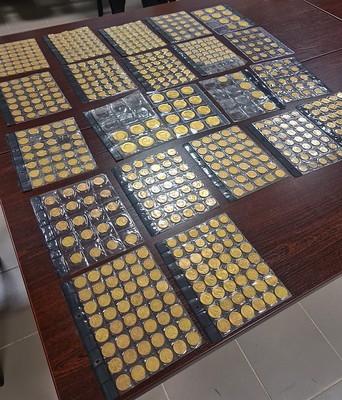 This is the bizarre moment customs officials found a pensioner with close to PLN 1.5 million (€320,000) worth of gold coins hidden inside her clothing.
This is the bizarre moment customs officials found a pensioner with close to PLN 1.5 million (€320,000) worth of gold coins hidden inside her clothing.
Officials discovered the five kilograms of gold coins during a routine search at the border crossing with Ukraine in Hrebenne south east Poland.
According to reports, after being stopped the 68-year-old woman disclosed her secret to the dumbfounded officers before revealing the 670 coins.
Spokeswoman Marzena Siemieniuk said: 661 of the 670 coins examined are foreign exchange gold, which includes, among others, gold coins minted after 1850.
Moreover, some of them are legal tender, i.e. circulation, coins.
The remaining ones are the so-called investment or investment coins, treated as a capital investment.
In turn, the remaining nine coins, minted before 1850, are coins of historical value.
The majority come from the 19th and 20th centuries, comprising crowns from the Kingdom of Hungary, French, Belgian, and Swiss francs, Austrian crowns, and British sovereigns.
Customs officials added that if the elderly woman had declared the stash before being stopped she could have done so legally without being fined.
To read the complete article, see:
Customs officials find pensioner with stash of gold coins worth 1.5million zl hidden inside her clothing
(https://www.thefirstnews.com/article/customs-officials-find-pensioner-with-stash-of-gold-coins-worth-15million-zl-hidden-inside-her-clothing-41410)
FEATURED WEBSITE: CARNATION, LLC
This week's Featured Web Site is Carnation, a maker of currency counting machines.
We are a Chicago-based manufacturer and distributor of currency counters who has been in the business since 2004. People all over the world have recognized the value that Carnation Money Counters delivers. We are currently selling our banknote counters to customers in Canada, Mexico, Europe, Asia, the Middle East, and many other countries around the world.


